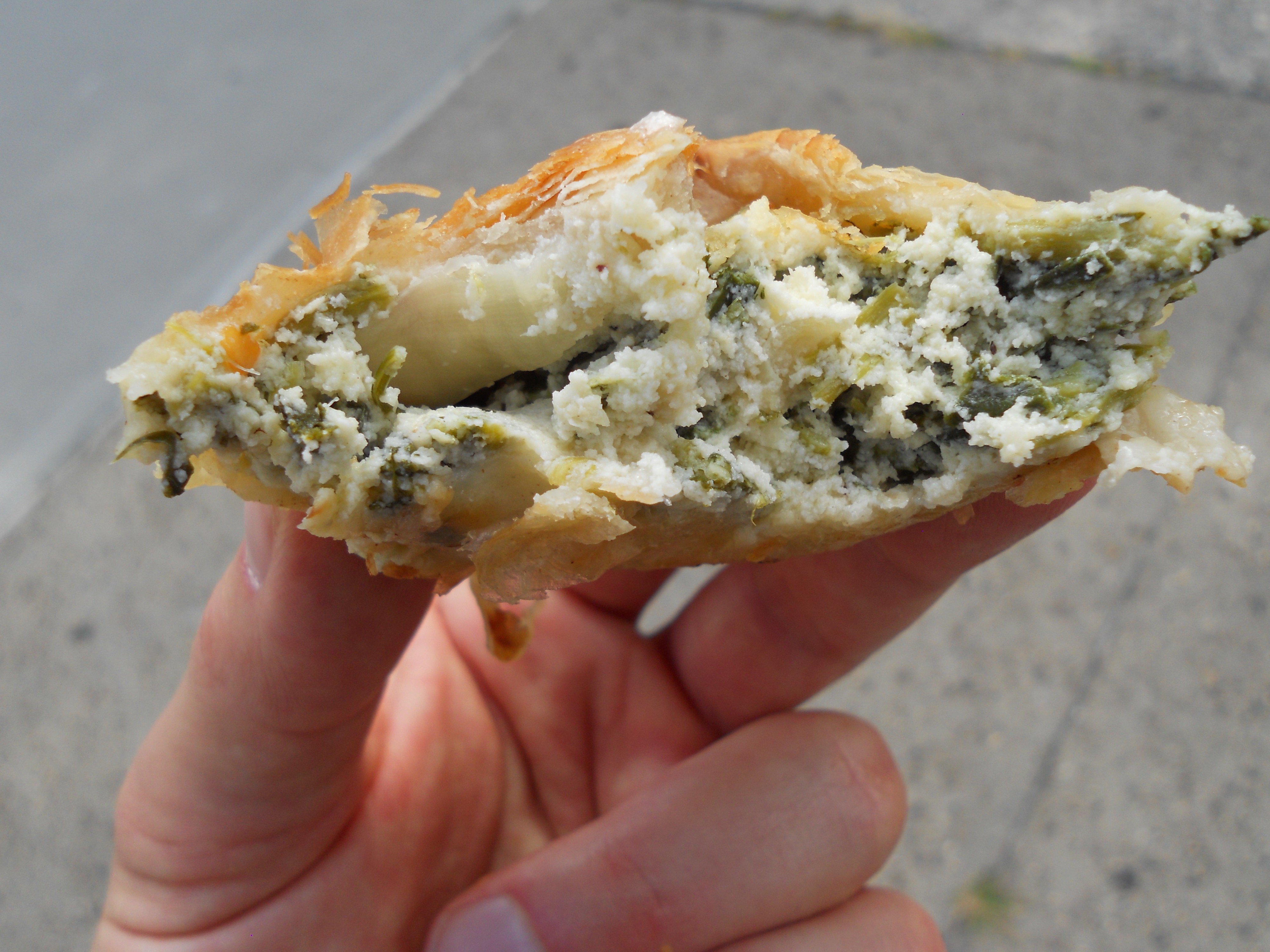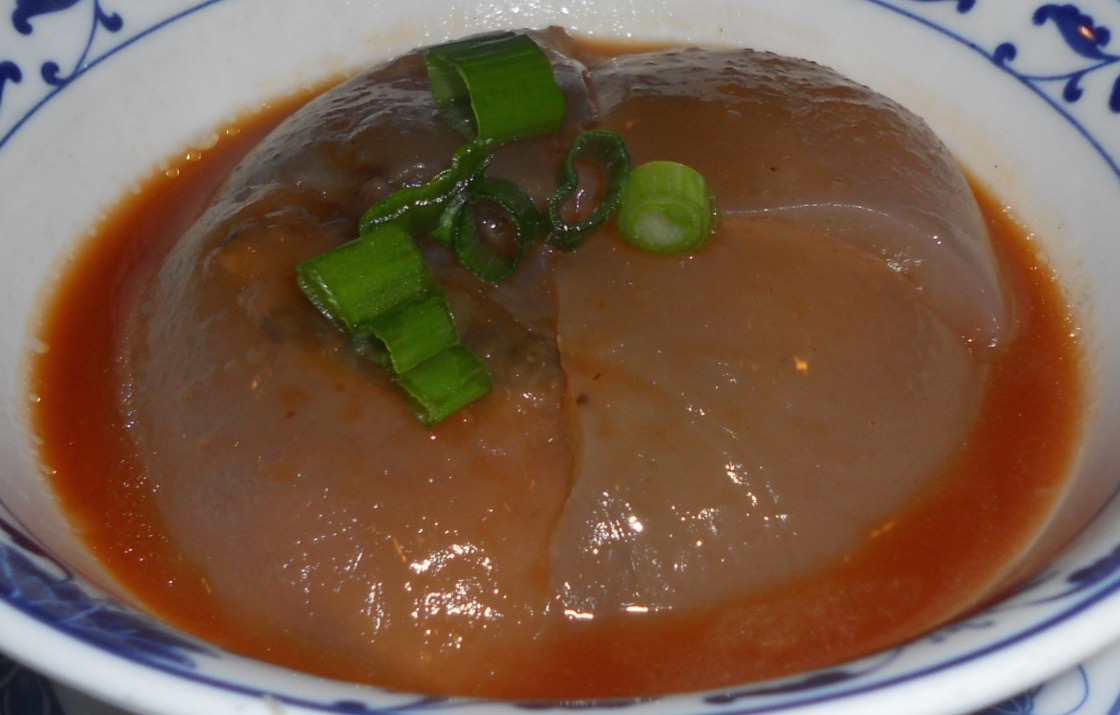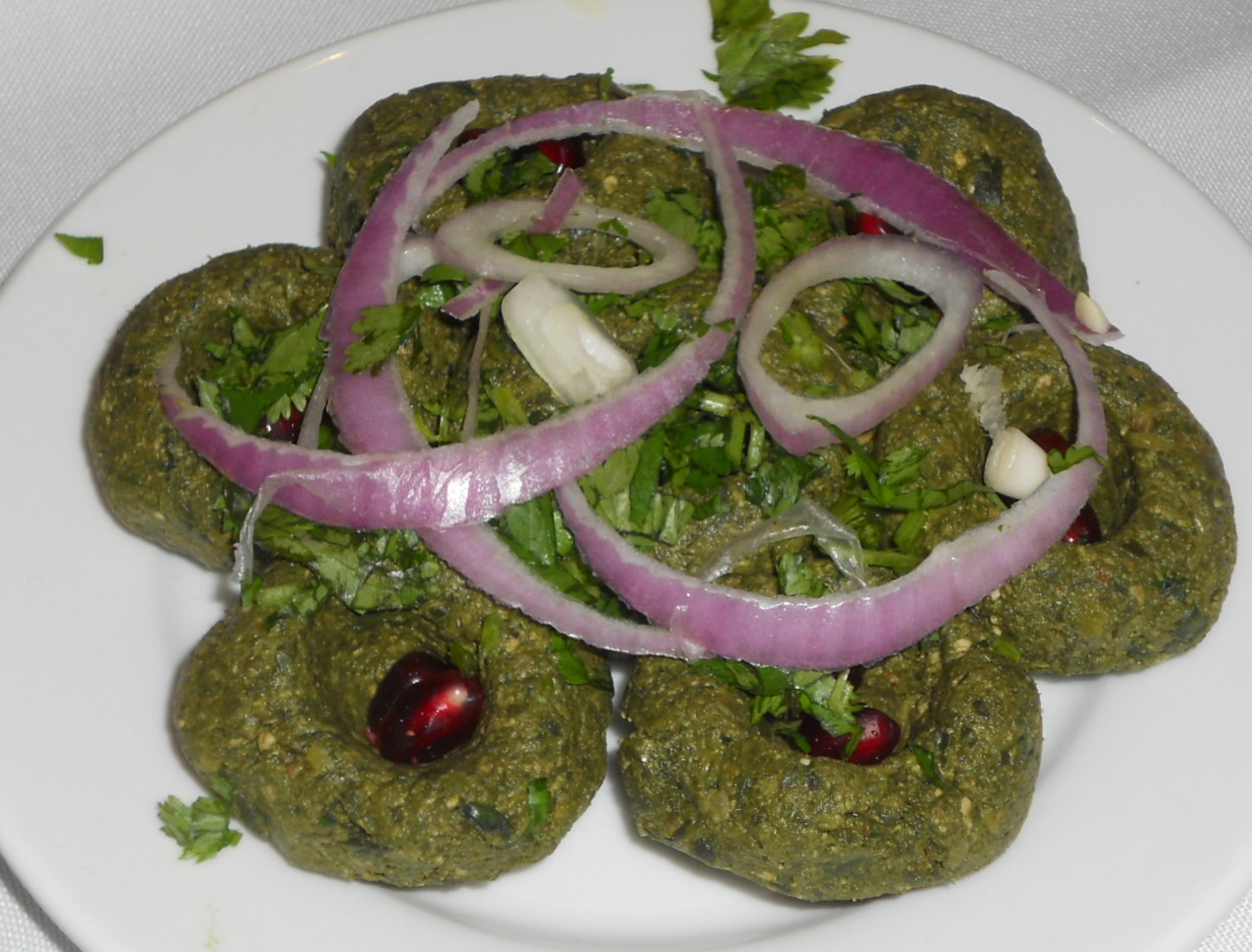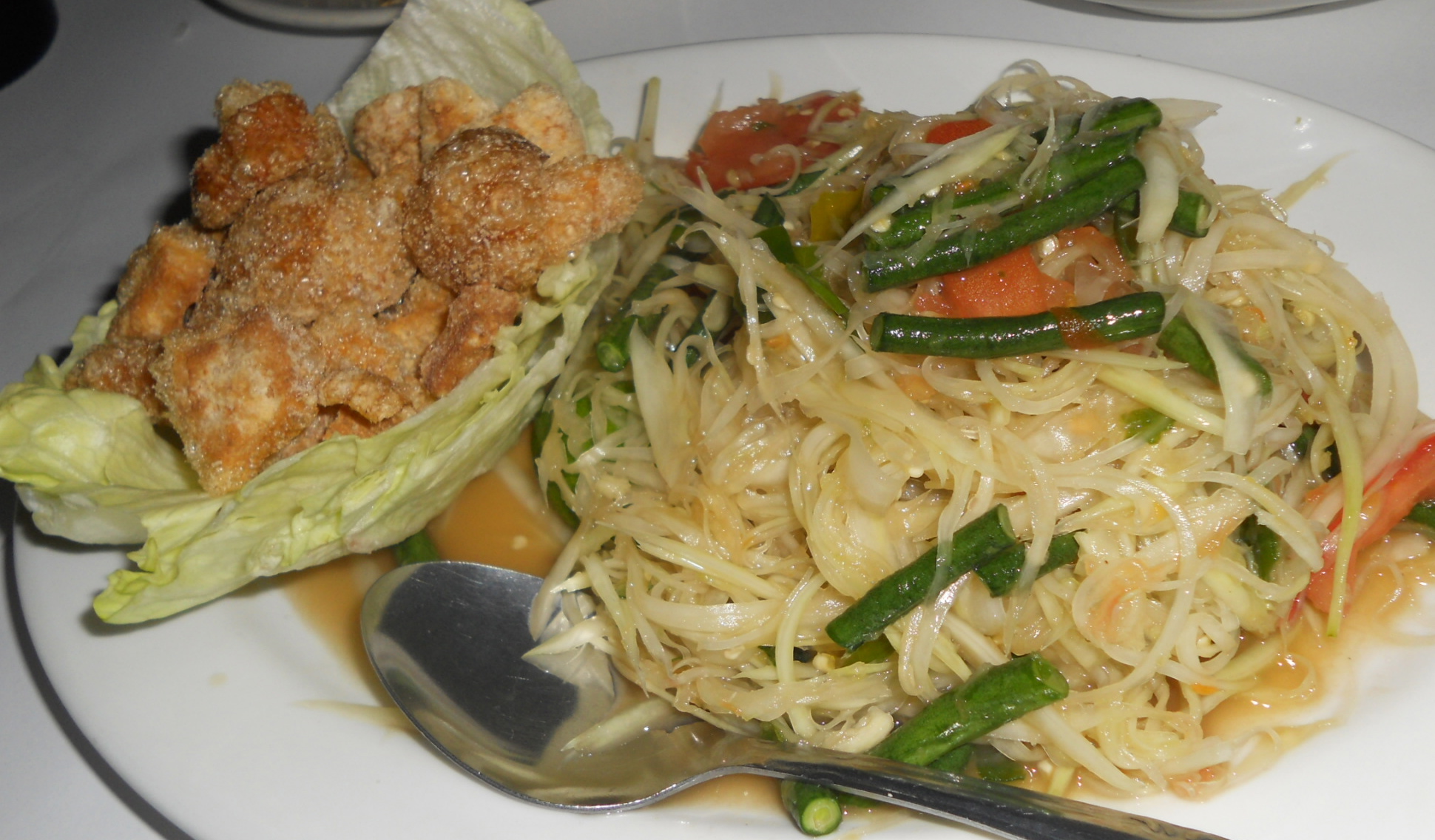|
|
As you can probably tell from my recent blog posts about non-Gambian food, Tunisian food, Kenyan food with an asterisk, and Costa Rican food with another asterisk, I’m starting to struggle a little. I have fewer than two dozen countries left. They’re hard.
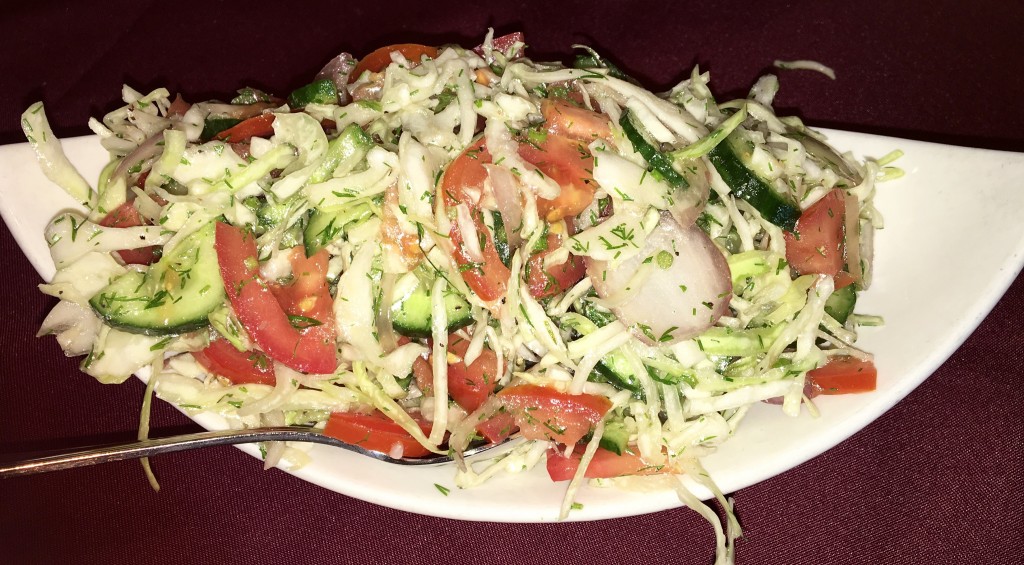 but eating a nice salad with assloads of dill isn’t hard, even if it’s not really Kyrgyz…
My latest desperate food-hunting activity: cold-calling United Nations missions, looking for somebody who might be willing to cook. The bad news: nobody answers the phone in most small-country UN missions, and I often get routed back to a cranky American operator at a central UN switchboard. But when I called the Kyrgyz mission, a very nice gentleman answered, and advised me to contact the New York City Kyrgyz Club if I wanted to find Kyrgyz food.
So I did that. Unfortunately, the NYC Kyrgyz Club seems to have vanished into thin air. I sent messages via email and Facebook. No response. When I called the Kyrgyz Club’s telephone number, the poor fellow who answered the phone explained that he didn’t know anything about Kyrgyzstan and wished that he had a different phone number.
I even tried to attend the Kyrgyz Club’s annual Nooruz celebration at 8:00 on a Monday morning, at the iconic Charging Bull statue near Wall Street – which, incidentally, the New York Stock Exchange tried to repress. I went to the bull at the appointed hour, and instead spent two hours munching bagels in a nearby café, eyeballing the bull through the window. Not a Kyrgyz in sight.
 my theory: the bull is charging because it’s hangry, and just wants some Kyrgyz ashlam-fu
So the Kyrgyz Club, sadly, seems to be nothing more than a rumor these days. Fortunately, the nice man at the Kyrgyz UN Mission also recommended that I eat at Nargis Café in Brooklyn. When I gently protested that Nargis Café is owned by people from Uzbekistan, not Kyrgyzstan, he didn’t flinch: “Yeah, but the food is pretty much the same,” the nice Kyrgyz gentleman responded.
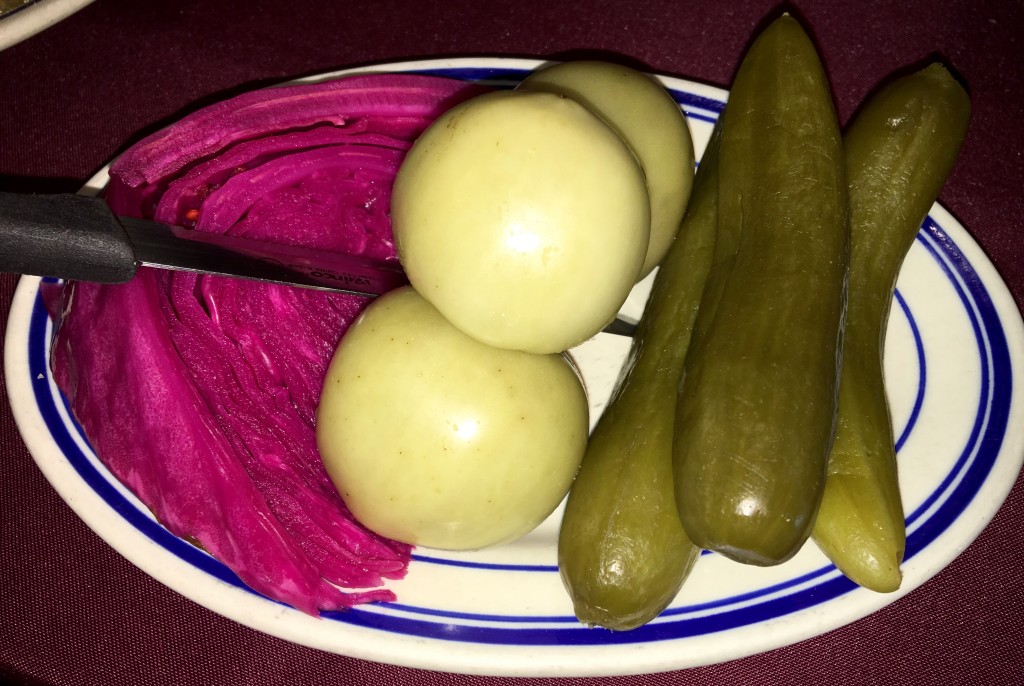 well, I guess it’s true that most central Asian pickle plates pretty much look the same…
Ironically, this was not the first time that I’d caught a Kyrgyz official with his hand in the proverbial Uzbek cookie jar. Years ago, I met a member of the Kyrgyz United Nations mission at a place called Alladin (not to be confused with Aladdin, a nearby restaurant with a different spelling) that served tasty Uzbek horse meat salad. Sadly, that particular place was wrecked by Hurricane Sandy a few years ago.
Anyway, I did what the nice Kyrgyz man said to do, and I ate at Nargis Café. The food was indeed amazing. We started with a hot loaf of bread (lepeshka) and salad bojon, a fresh eggplant spread with garlic:
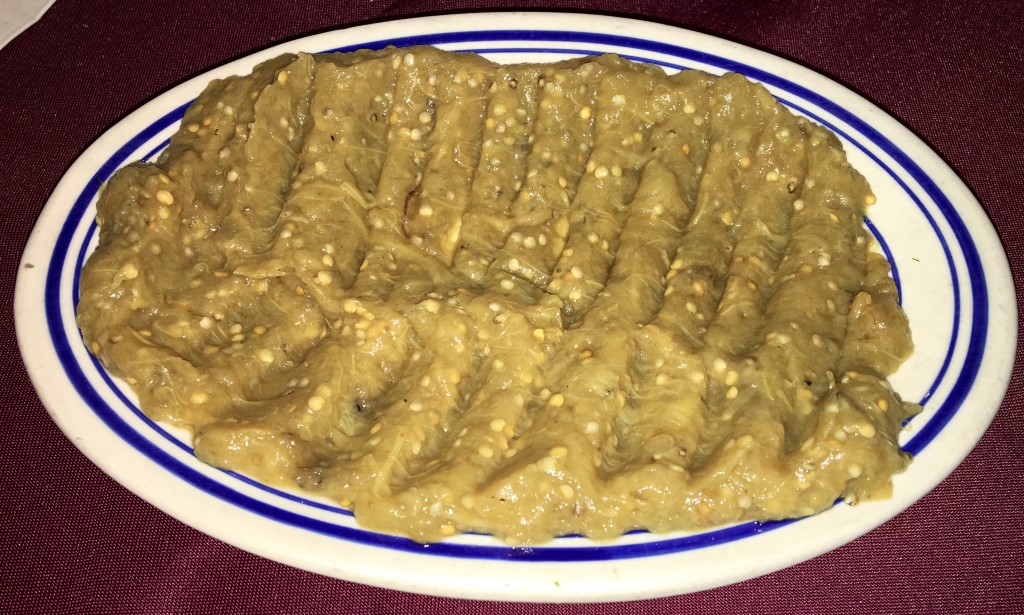
We then ate a couple of different dumpling-like creatures, starting with khonim, consisting of pasta-like dough stuffed with beef, lamb, potatoes, and onions, and served with tomato and yogurt sauce:
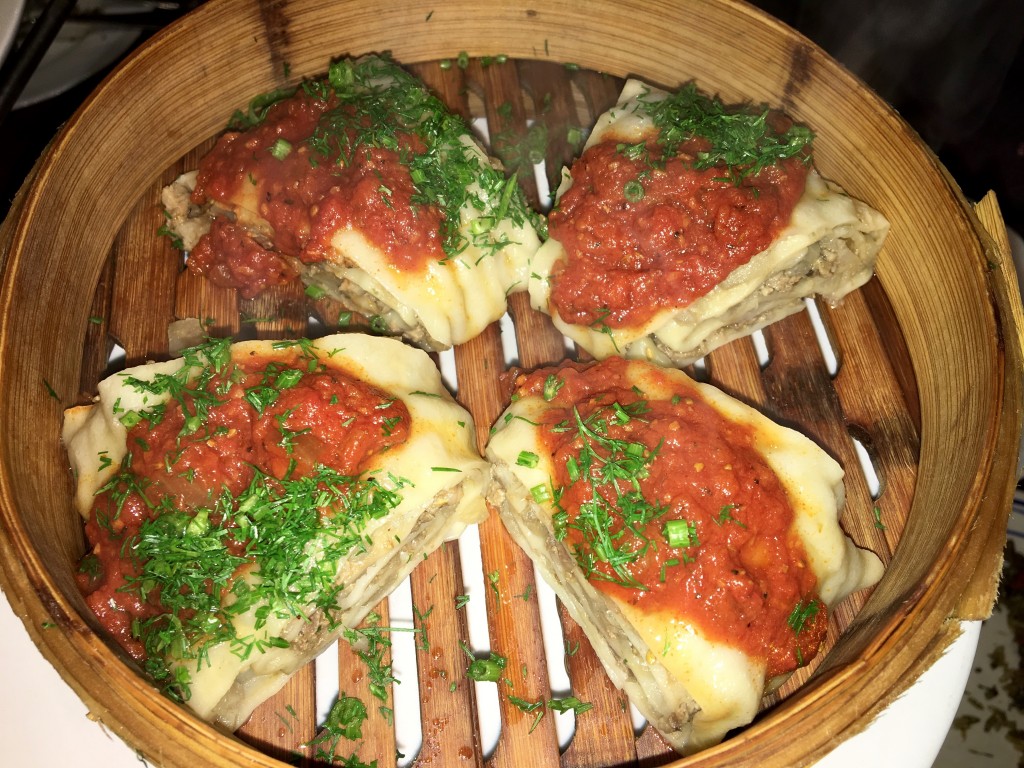
And then there was an excellent and unique version of manti – stuffed with pumpkin, of all things:
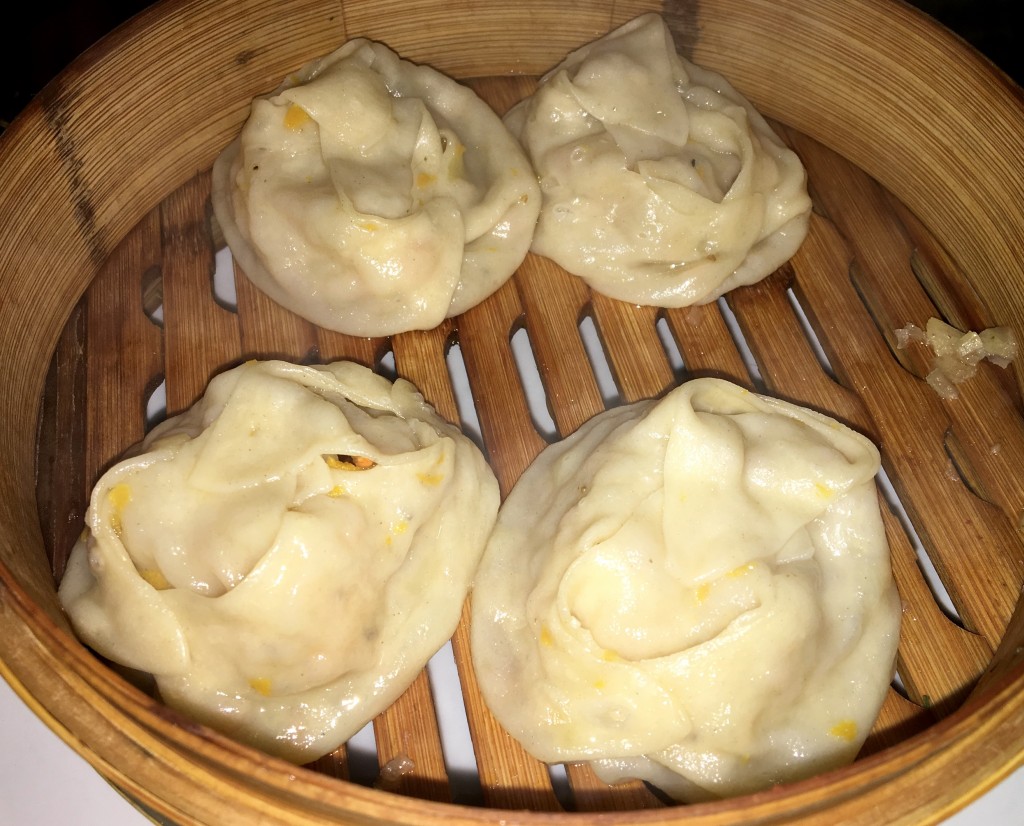
Here’s lagman stew, made from vegetables and meat in a nice, beefy broth, with plenty of dill and other herbs:
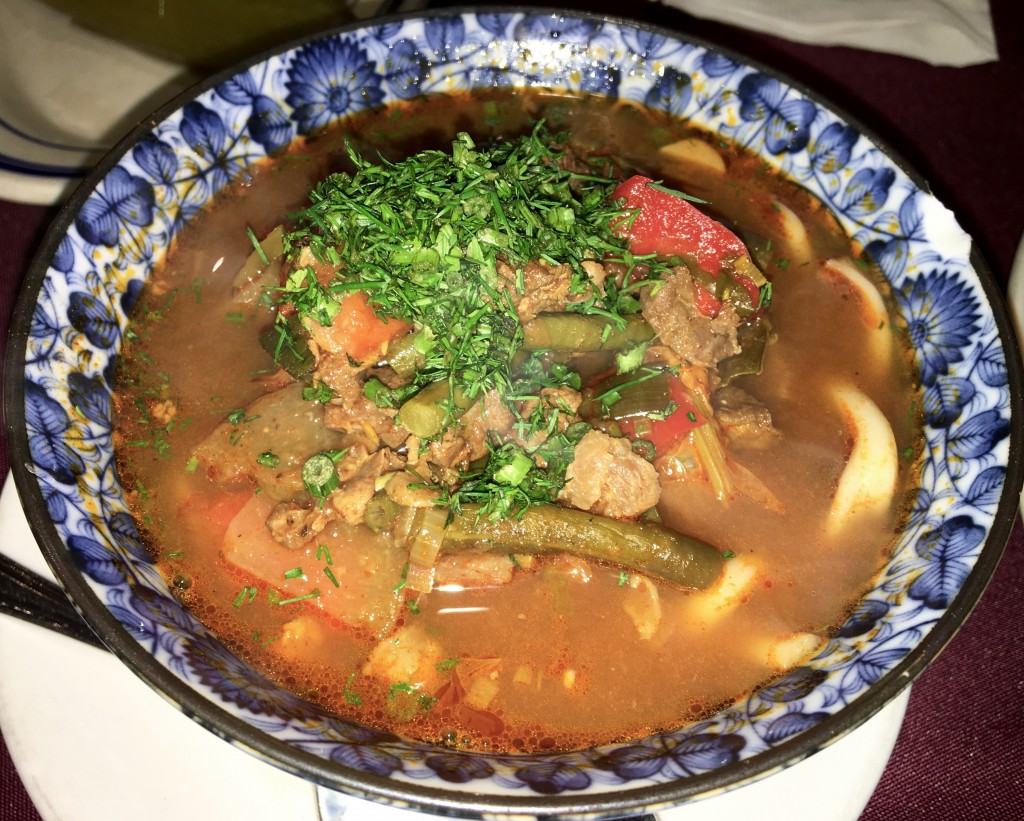
And my very favorite dish of the day was bhash, translated on the menu as “green plov.” I’ve never met a plate of central Asian plov I didn’t like, and I’ve even eaten it from Ziploc bags on random street corners. But this version was particularly special. The description on the menu was both amusing and accurate: “diced lamb, chicken and liver, and good amount of mixed herbs, very tasty.”
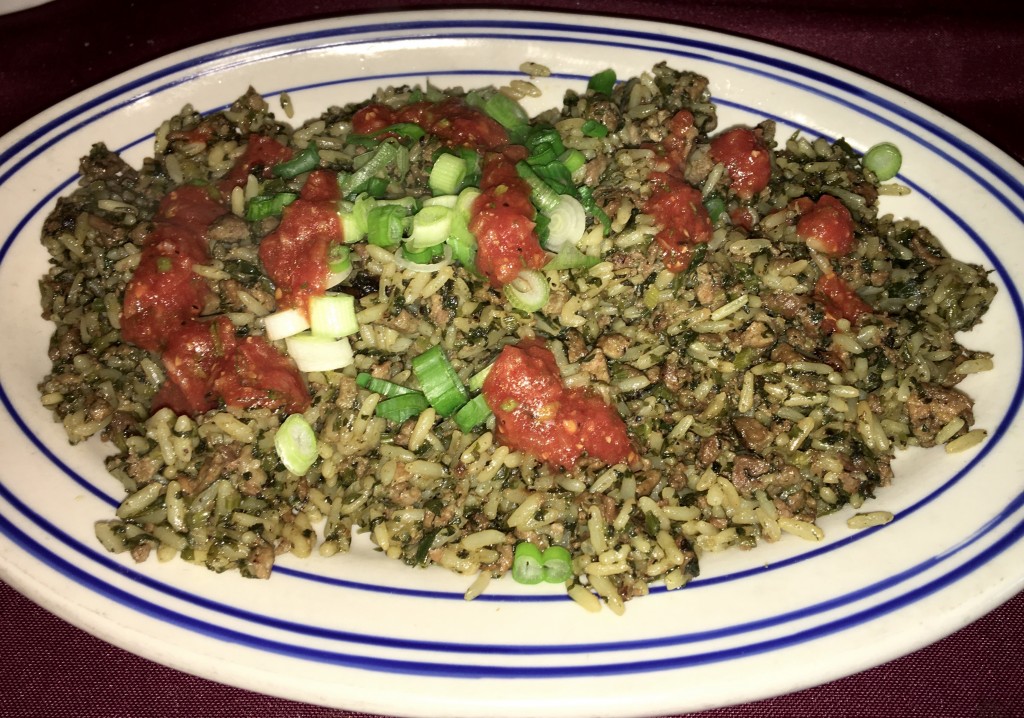 yup, very tasty
So yeah, the fellow at the Kyrgyz UN mission was completely correct: Nargis Café is pretty badass.
But here’s my dirty little secret: I ate legit Kyrgyz food in Brooklyn a long time ago. I just never wrote about it.
For a hot second several years ago, there was a restaurant in Brooklyn – not too far from Nargis Café – named Café Avat, with a Kyrgyz chef. I ate there, took photos, then forgot about the whole thing. Apparently, the brain cells tasked with remembering the event were killed in another tragic bourbon accident.
I figured that it was no big deal if I didn’t write about it right away, because it’s not like the restaurant would vanish into thin air or anything. I mean, I could always go back and eat another meal there…
Oh wait. Yeah, that place did vanish into thin air. But the food was pretty good. Hey, look – kabobs and pickles!
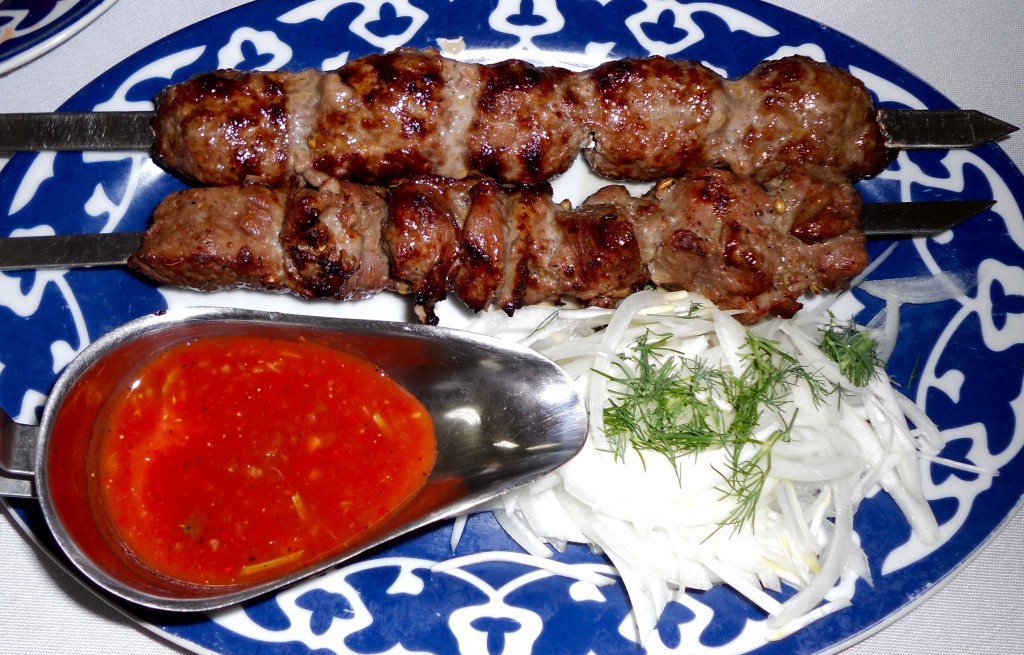
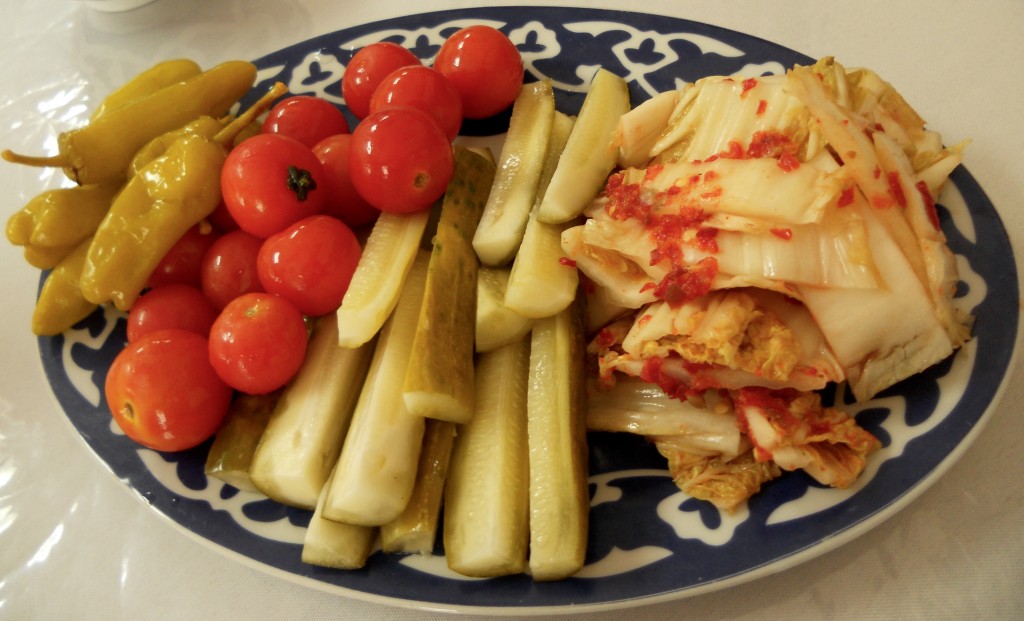
And this one here is hanim – very similar to Nargis Café’s dumpling-like khonim, but stuffed only with shredded potato, and served with a tomato sauce:
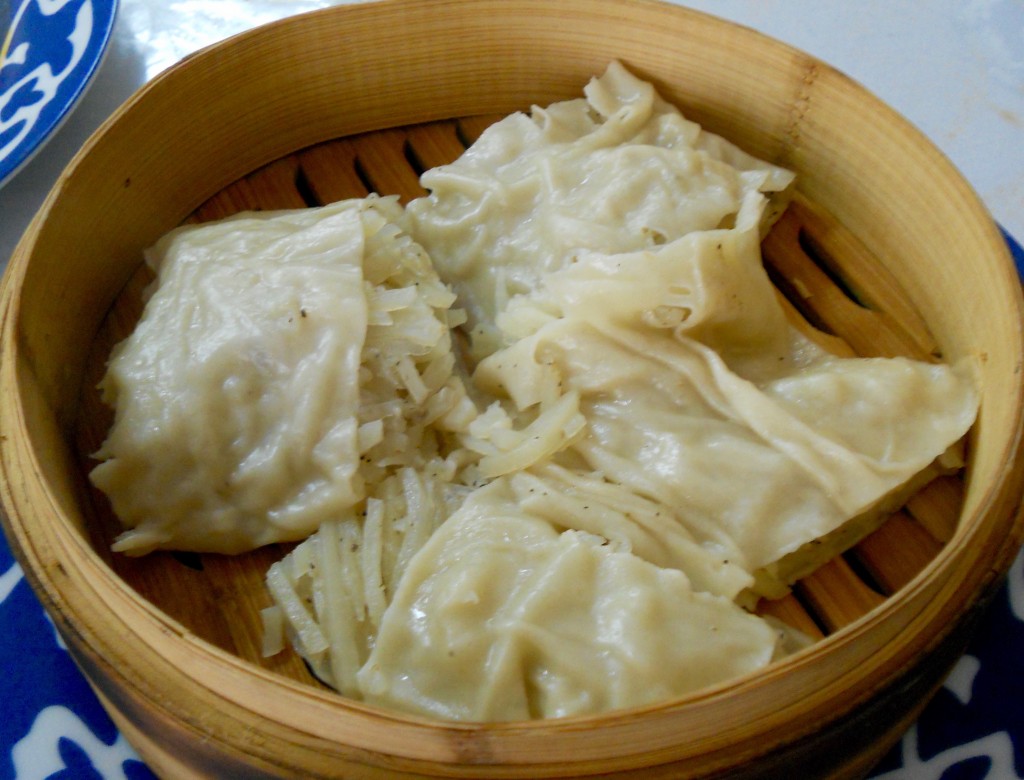
My favorite dish of the day was probably the pleasantly beefy and garlicky gan-fan, which is similar to the lagman stew that’s popular throughout the region, except that gan-fan is served atop rice, instead of in a noodle soup:
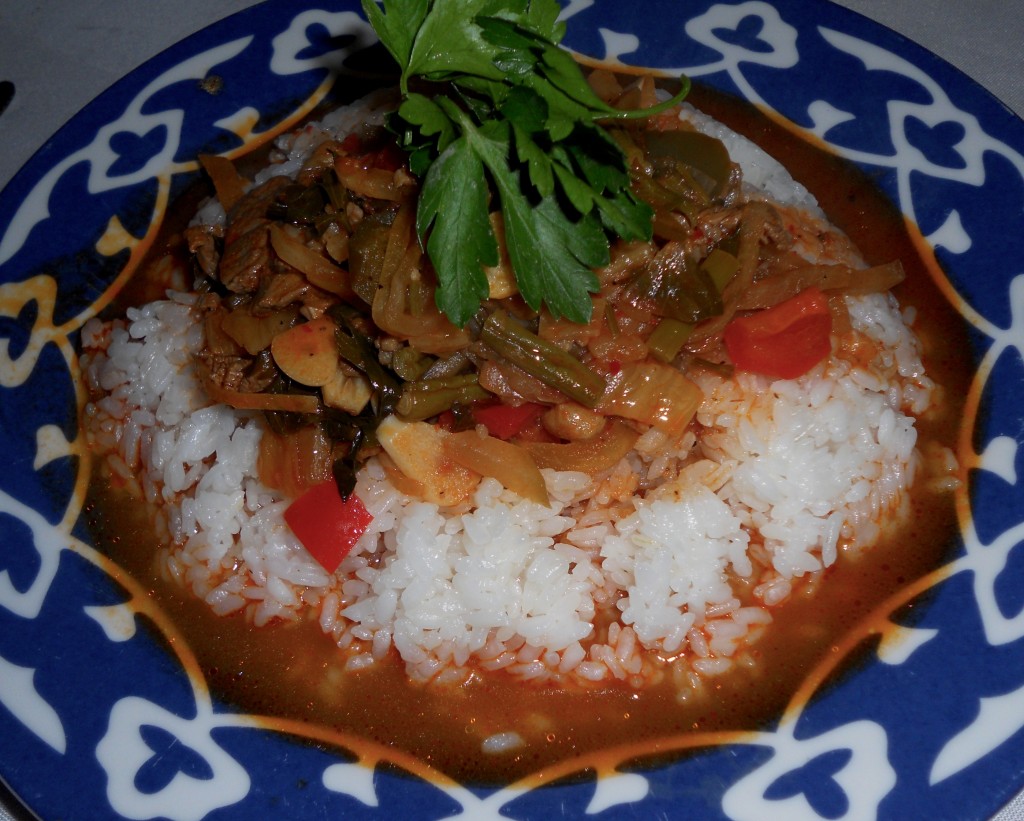
And finally, there was the ashlam-fu, a cold cucumber, tomato, and noodle salad, topped with a red-pepper sauce and served with an interesting twist: totally non-photogenic slabs of bright-white mung bean jello. Fascinating, and unlike anything else I’ve ever seen in a salad:
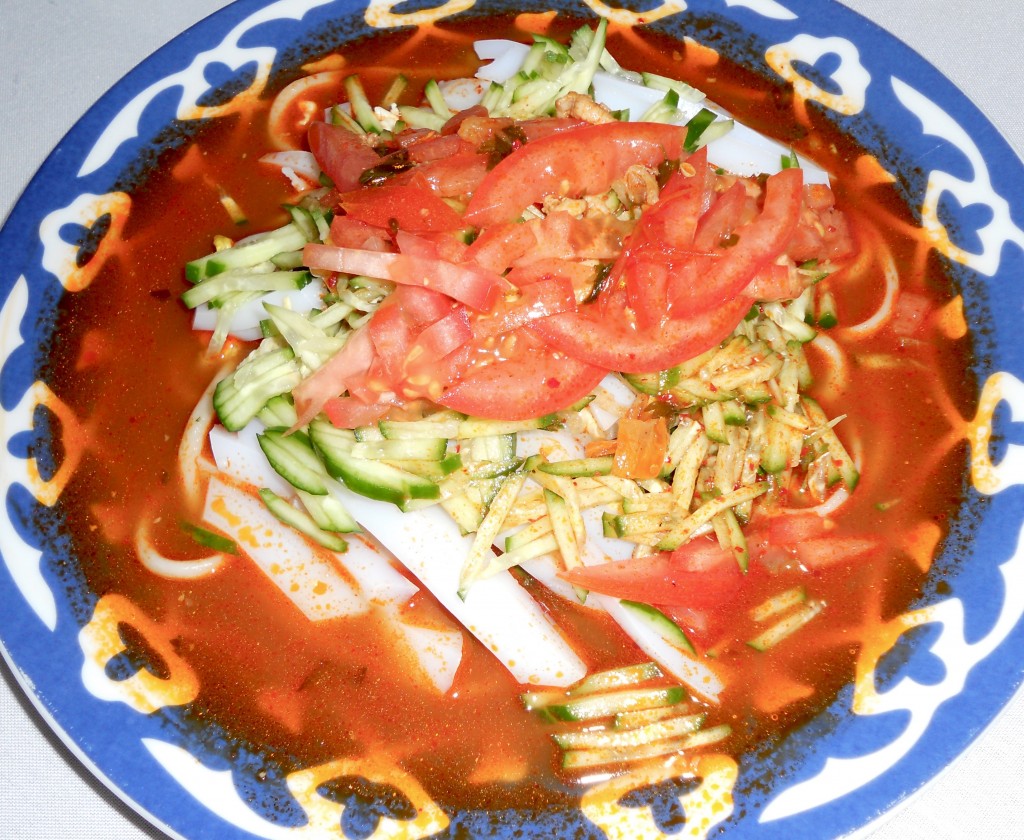 jiggle jiggle
So yeah, I’ve had Kyrgyz food, prepared by a Kyrgyz chef in New York City. You can’t have any though, because I’m a crappy food blogger, and the restaurant is long gone.
But there’s nothing wrong with doing what the Kyrgyz diplomats tell you to do: just go to Nargis Café, and order something with lots of green herbs in it. I suppose that it’s much easier than hanging out with an angry bull statue, hoping that Kyrgyz food will magically appear.

Nargis Cafe
2818 Coney Island Avenue, Brooklyn
Subway: Sheepshead Bay (B, Q trains)
Know of anyplace that still serves Kyrgyz food? Any idea where Cafe Avat’s Kyrgyz chef might be working now? Want to help me find other hard-to-find cuisines? Email me at [email protected], or find me on Twitter (@UNofFoodNYC) or Facebook. If you find me something blog-worthy, I promise not to be a slow lazy starchy ball of soggy calories, and I’ll actually write the post before the place closes down next time.
|
|
|
I hate to be one of those food bloggers who massively overuses the word “best”, but I think I might have eaten the best African food of my life recently. And that’s saying something, since I’m a little bit obsessed with African food.
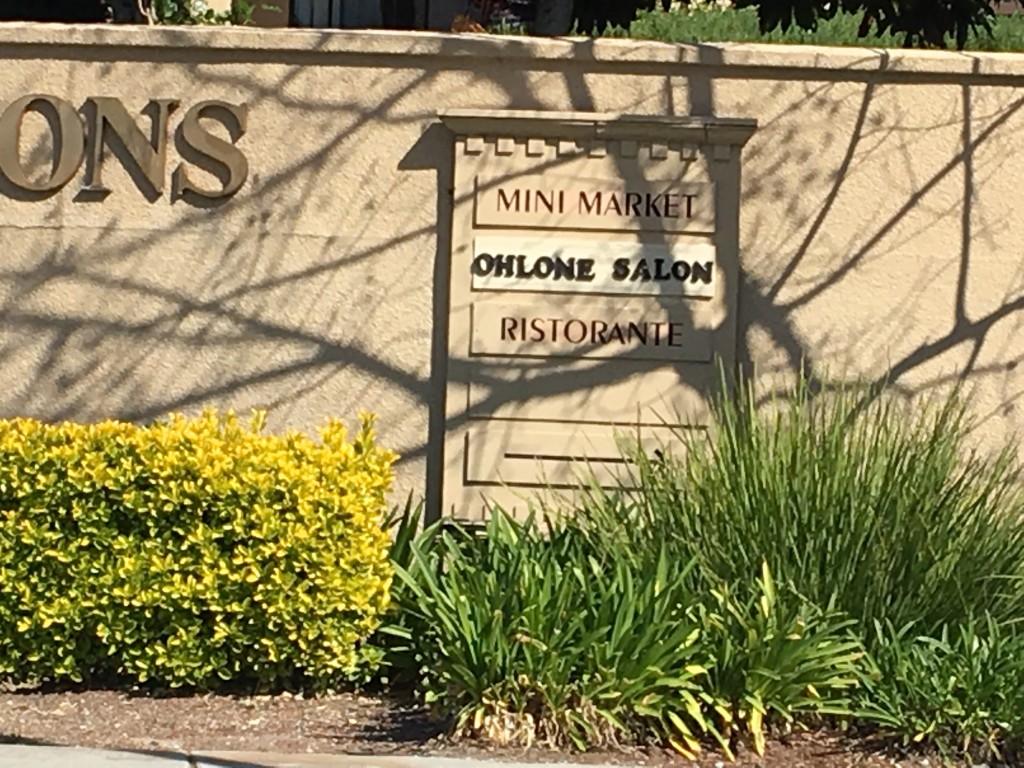 I didn’t see anything that you’d call a “ristorante”, but I did see some awfully tasty green sauce
Jubba Restaurant, in sunny San Jose, California, is incredibly easy to miss. Drive forever through some urban sprawl, turn into the nondescript housing subdivision when you see the tiny sign that inexplicably says “ristorante,” continue to the light rail station, then the follow the smell of Somali food to a place that really doesn’t look like it should serve Somali food, because it’s right next to a freaking suburban train station.
Then pretend you’re a hippo and eat everything, because holy crap, this place is amazing.
Jubba is owned by an incredibly friendly family of Somalis who know how to handle their meat. The menu is small, and that’s a good thing – really, do you need more than a dozen items, when all of them are phenomenal?
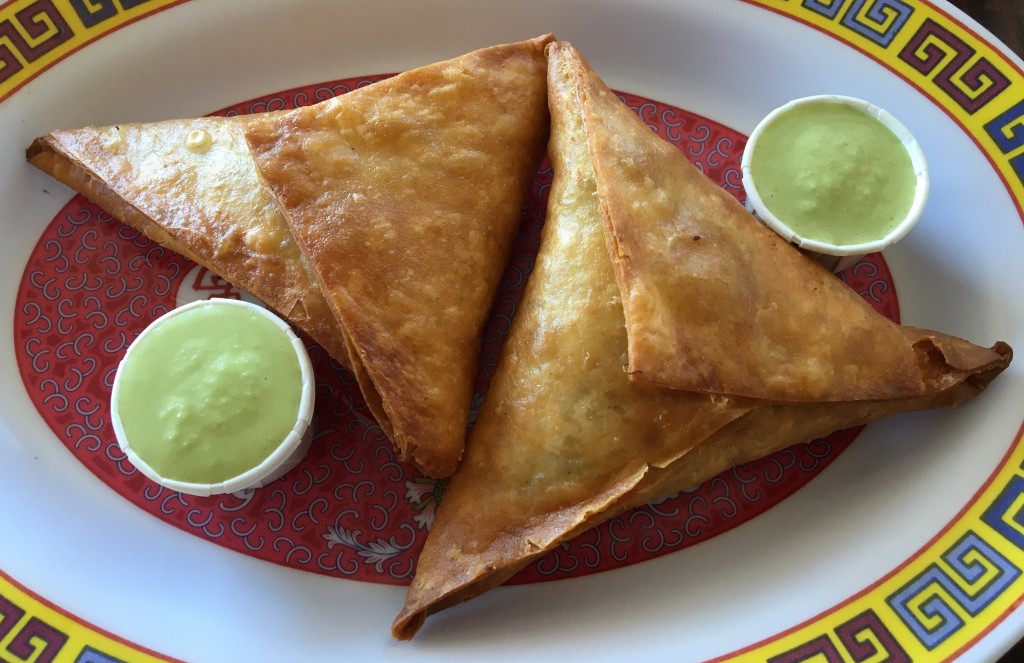 phenomenal sambusas, with tasty green sauce
We started with some underpriced fried appetizers: mandasi (fried dough made with coconut milk, $1), and probably the most perfectly seasoned sambusas ($1.50) – the East African version of samosas – I’d ever eaten, stuffed with finely minced beef, onions, and spices. Both appetizers were served with a magnificent green sauce that looked like some sort of avocado cream sauce, but tasted like it might have a mix of chilies, onion, and maybe clove and ginger. I loved it.
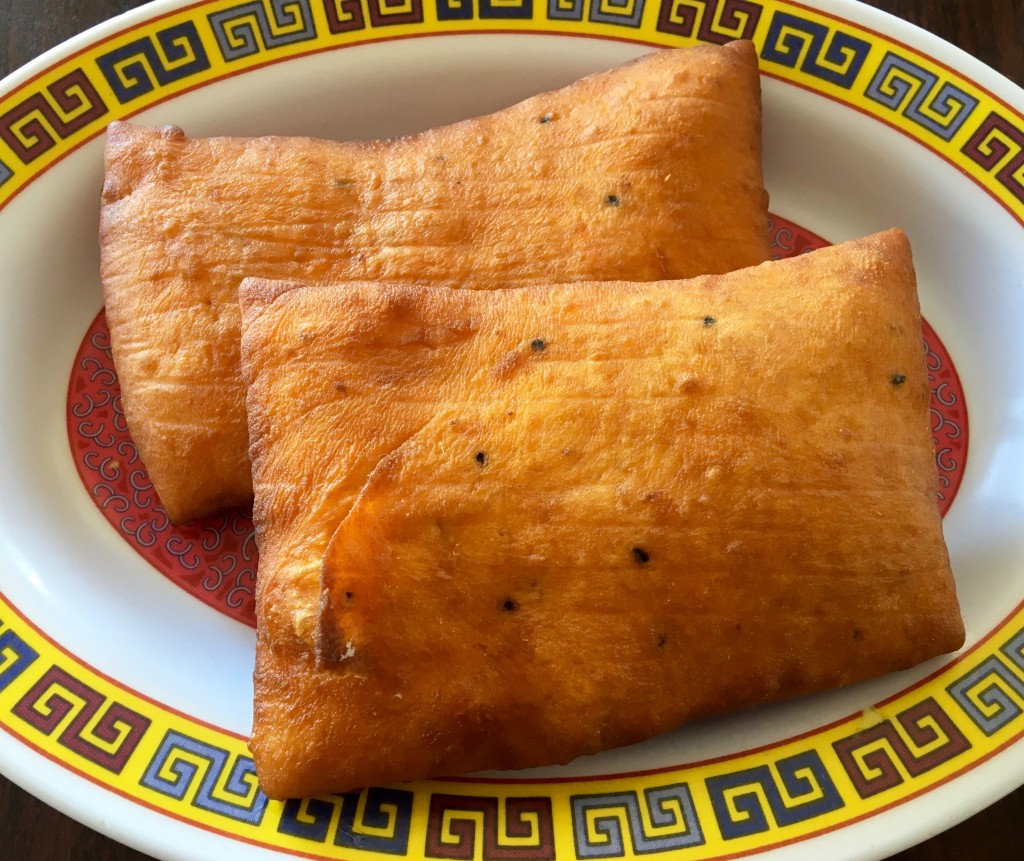 nice coconut pillows
We ordered four entrees, all of which looked remarkably similar – but were absolutely ludicrously delicious. It’s like these guys have some sort of magic frying pan back there: the onions were beautifully caramelized, and everything had this amazing char to it. And maybe tamarind and a bit of cumin and ginger? I don’t know. But it was epic.
Here’s the beef suqqar, also served with mixed vegetables and a side of chapatti, a grilled flatbread that’s popular in East Africa:
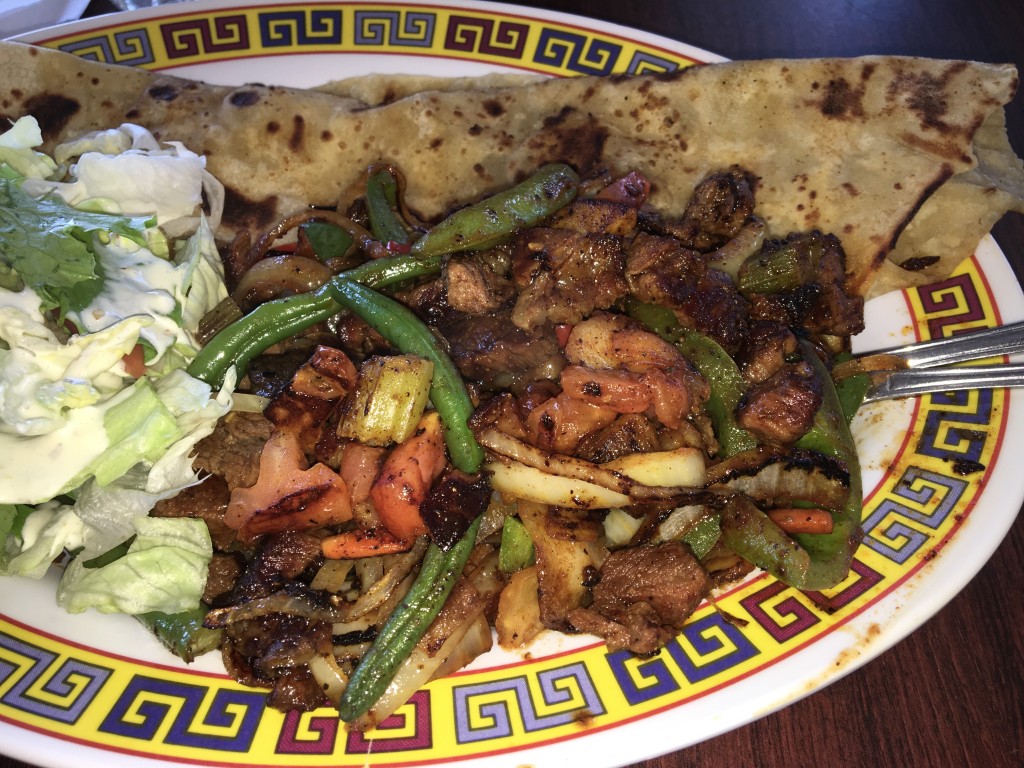 beefy
And this is the chicken suqqar with vegetables, served with a side of injera, a much spongier, slightly fermented flatbread:
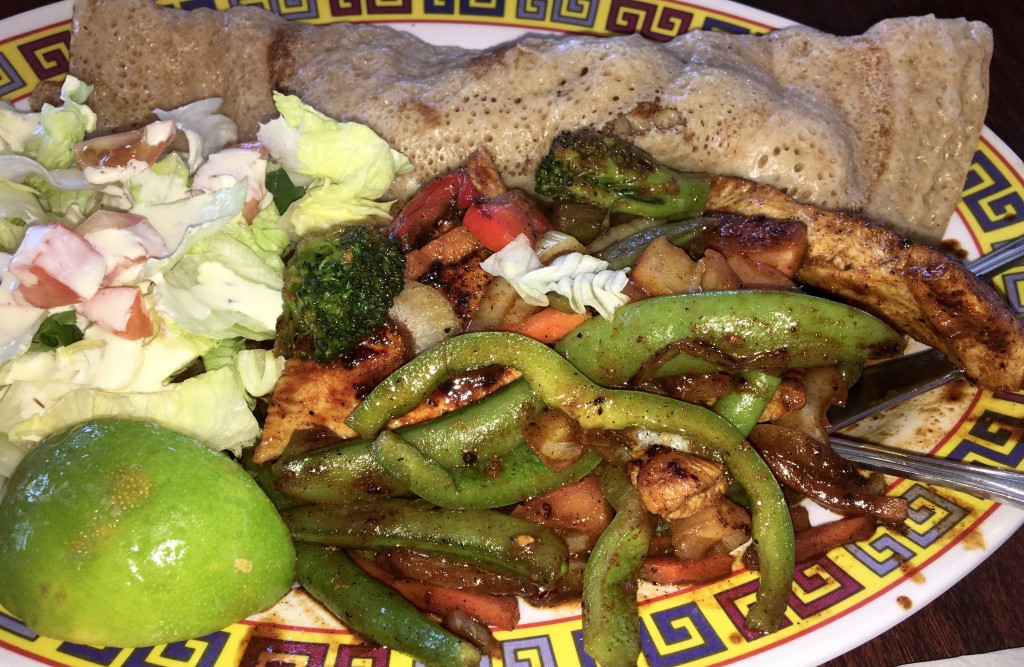 not beefy
Here’s the tilapia with vegetables, served with rice :
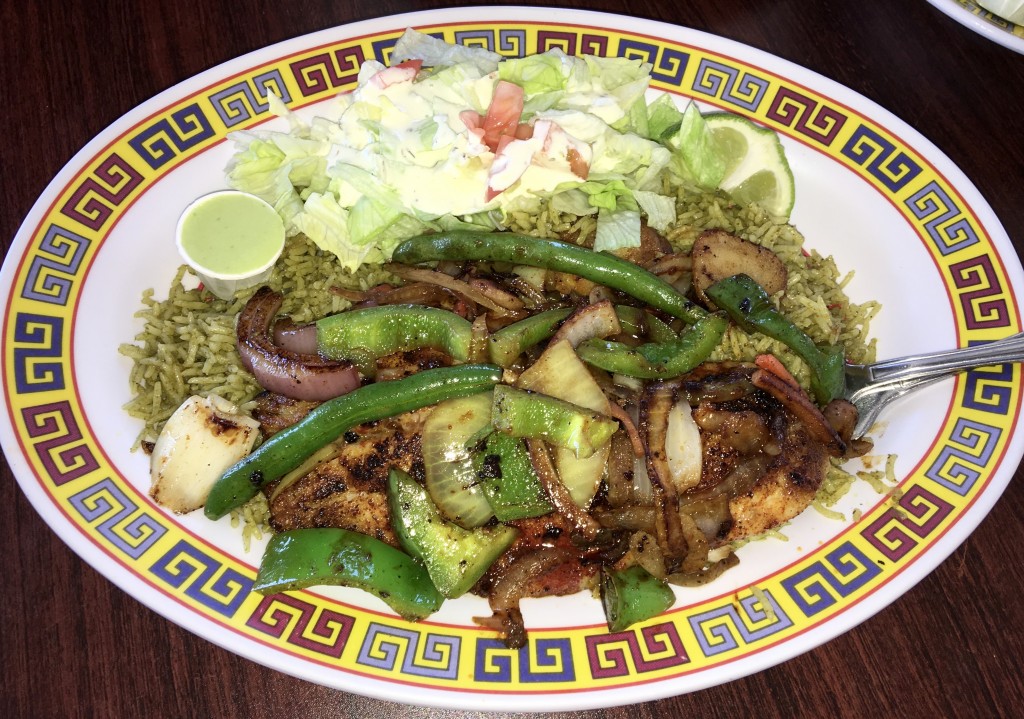 wait… water chestnuts?!
Before I continue: yeah, there are water chestnuts on that fish. Nearly all of my previous encounters with water chestnuts have been in Chinese dishes, and I’d never thought much of them – they’re usually canned and bland. But they were amazing in Jubba’s dishes – a crunchy change-of-pace vegetable, just when you need it in the middle of a strong-flavored meal.
And then there’s my favorite thing ever: goat.
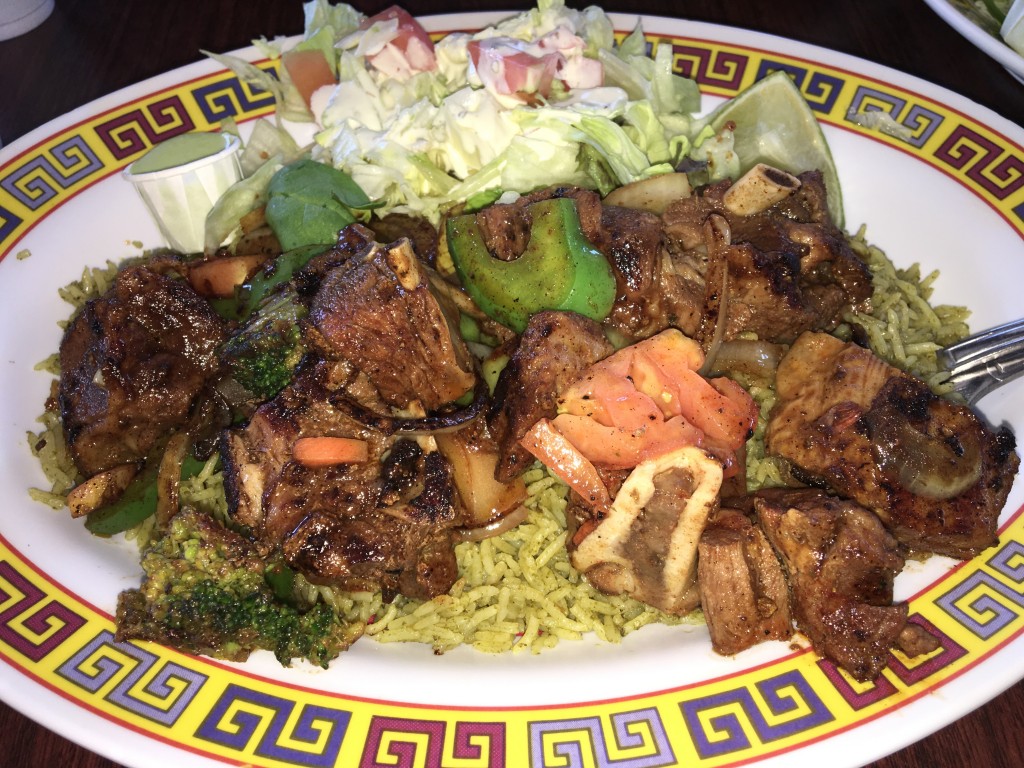 better than beefy
You know, I used to think that goat was gamey and unappealing. When I ate an Uruguayan chivito (literally, “little goat”) sandwich, I was totally relieved that it didn’t contain any actual goat. Now, I love the stuff – it strikes me as being more flavorful than most meat; beef seems bland and stringy by comparison.
Anyway, Jubba’s goat is charred like a boss, and served with more of those deliciously caramelized vegetables and a side of rice. (“Charred like a boss” – um, that’s a phrase, right?)
You know I’m stoked about the food when I insist on taking pictures of the owners and staff. I know – it’s a really silly habit, but these guys are pretty awesome:
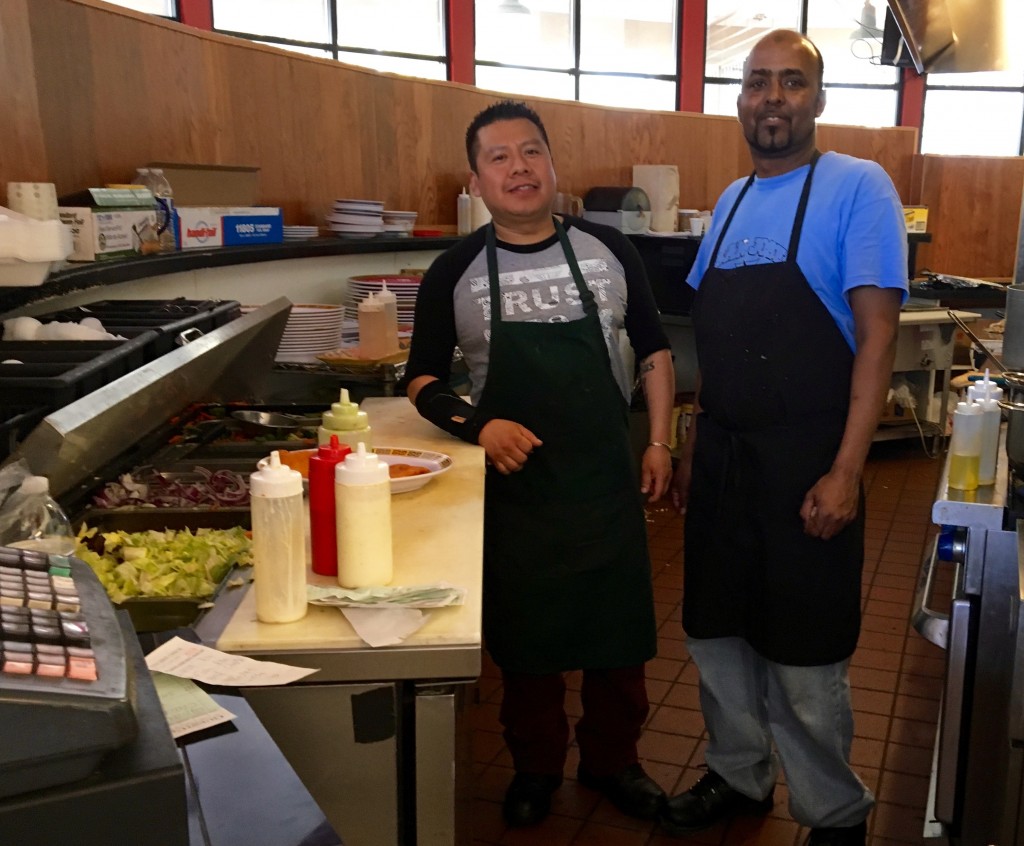 take a bow, gentlemen
The worst thing about Jubba? It’s in San Jose. I don’t live in San Jose. It’s too bad that the subway can’t take me to this random-ass subdivision of San Jose for $2.75, no matter how many times I swipe my Metrocard.
Jubba Restaurant
5330 Terner Way
San Jose, CA
|
|
|
New Yorkers love to whine about the Mexican food here. I sorta understand why: Chipotle and Qdoba easily sell more burritos (which, incidentally, were pretty much invented in California) than every other Mexican restaurant in Manhattan put together.
Don’t get me wrong: I like a good Chipotle burrito as much as the next guy. But I love mole and fresh tortillas and the bazillions of interesting Mexican dishes that go way beyond tacos and burritos. Hell, UNESCO declared Mexican food one of the world’s great cultural treasures a few years ago.
The UNESCO declaration focuses primarily on the traditional foods of Michoacán, which are tough to find in New York, but if you venture to the South Bronx, you can find Mexican regional treasures of a different sort: Oaxacan food, served by the wonderfully warm family that owns La Morada, a charmingly quirky restaurant with purple walls and an outstanding book collection.
Like any good Mexican restaurant in the United States, La Morada offers a familiar array of tacos, burritos, and enchiladas, as well as the glorious sound of… holy crap, are they hand-making my tortillas and pounding my guacamole right now? Killer.
The tamales are pretty good, too:
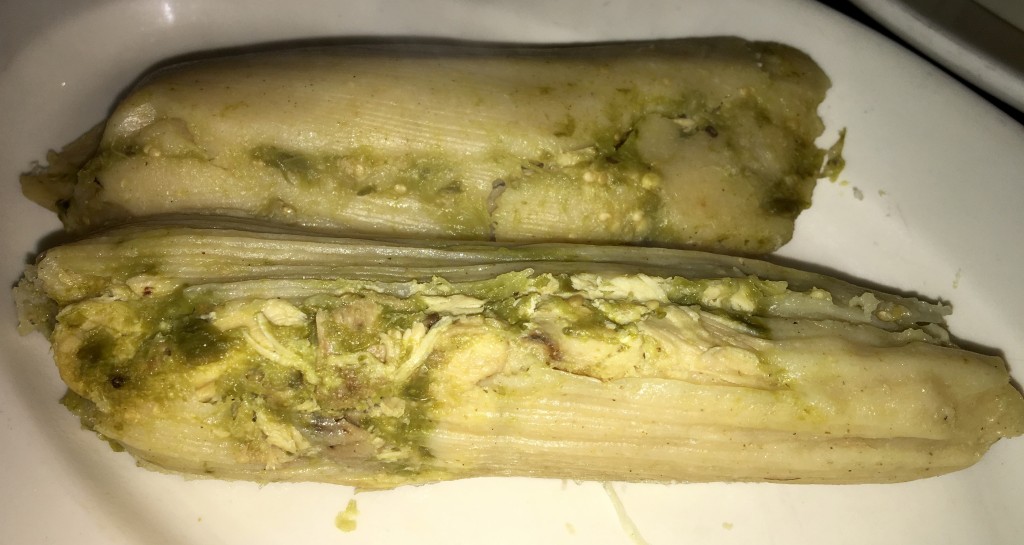
And the gorditas – blissfully obese corn patties stuffed with cheese, salsa, and veggies — might look pretty familiar, but La Morada also makes the gorditas by hand for each order:
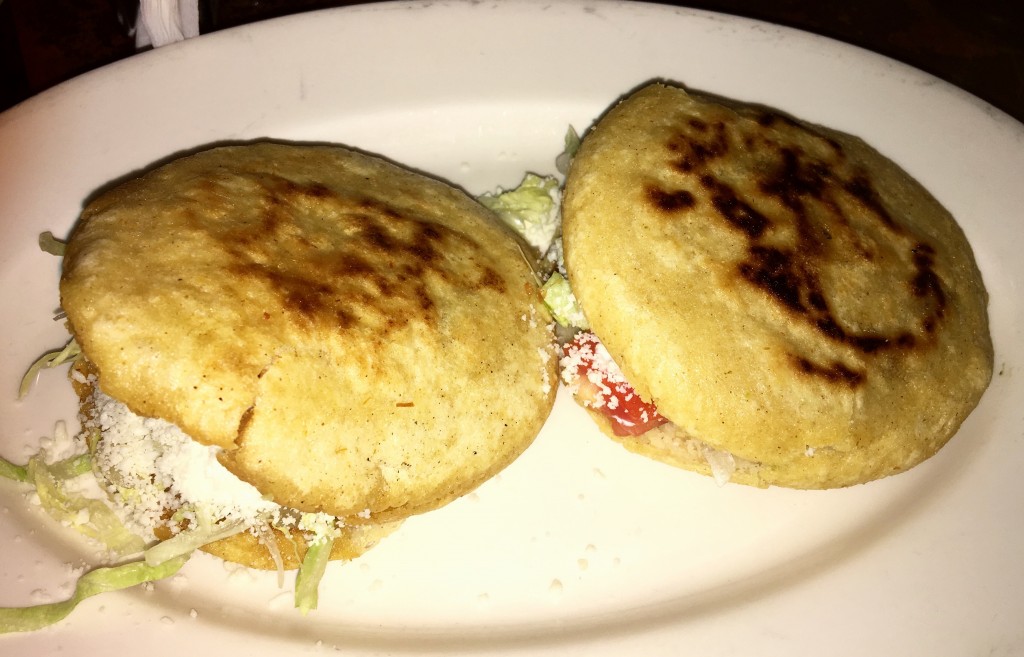
And I’m sure that you’ve seen chicken stewed in a green sauce, but this is a little bit different: it’s green mole sauce, made with green chile and (usually) pumpkin seeds, among other ingredients:
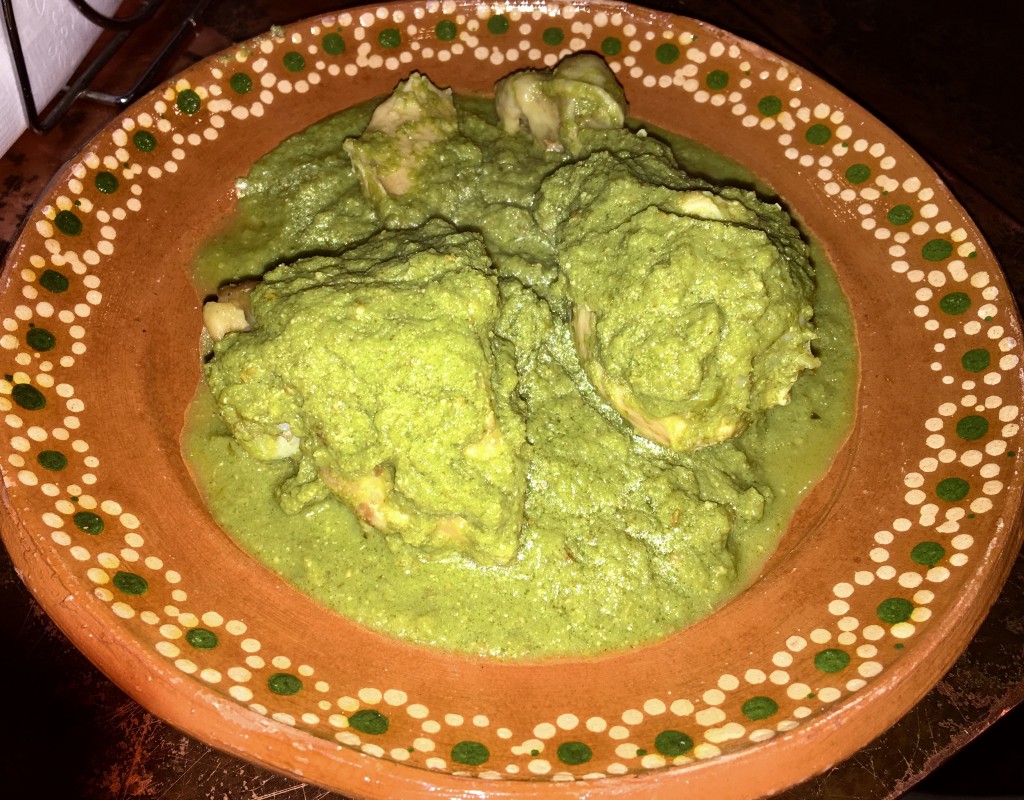
And I’ll admit that mole blanco isn’t exactly the most photogenic thing ever: it just looks like cream sauce. And mole blanco usually does contain milk, but the list of other potential ingredients is fascinating: peanuts, sunflower seeds, white pinion nuts, white corn tortillas, banana, onion, or apple, depending on the exact recipe. We ordered ours atop a chile relleno, a moderately spicy fried chile stuffed with cheese:
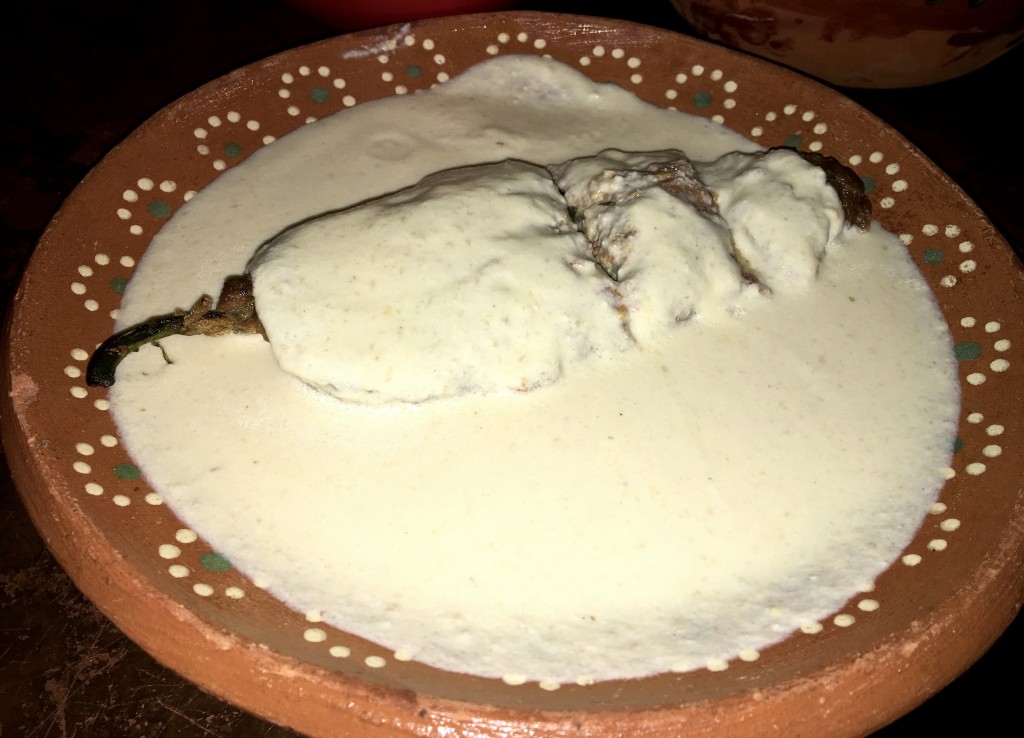
And then there was barbacoa — roasted lamb:
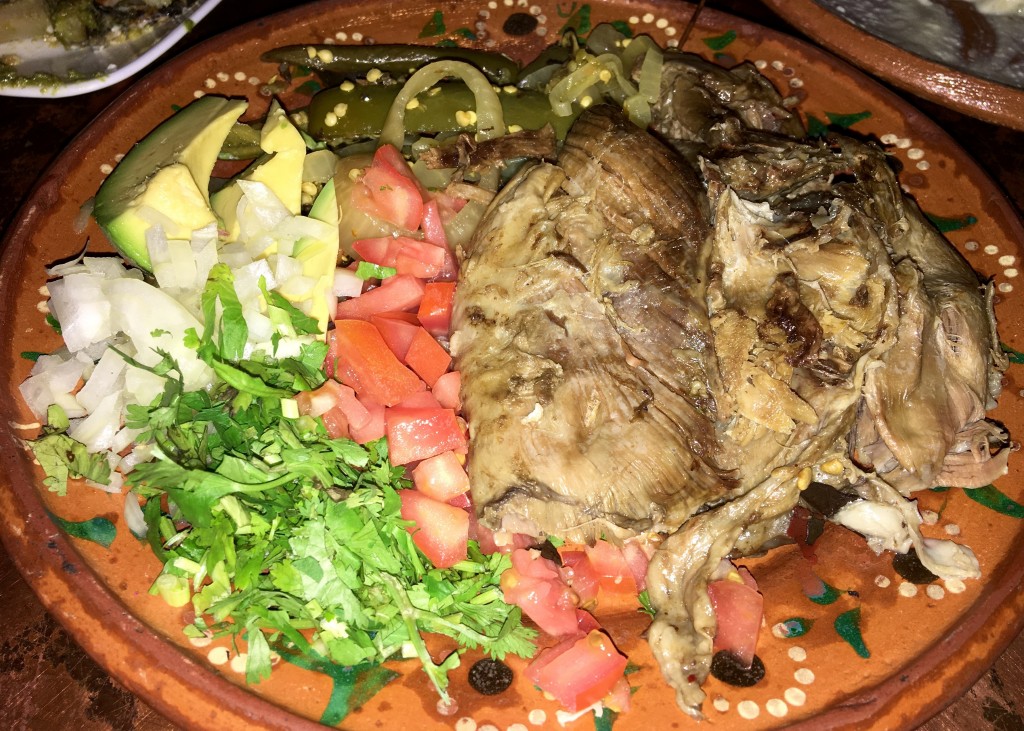
But one of my two favorite dishes was the mole oaxaqueño – a ferociously red sauce with a hearty dose of chilies, typically blended with raisins and nuts, among other ingredients. Ours was served with pork and a side dish of lousy photography:
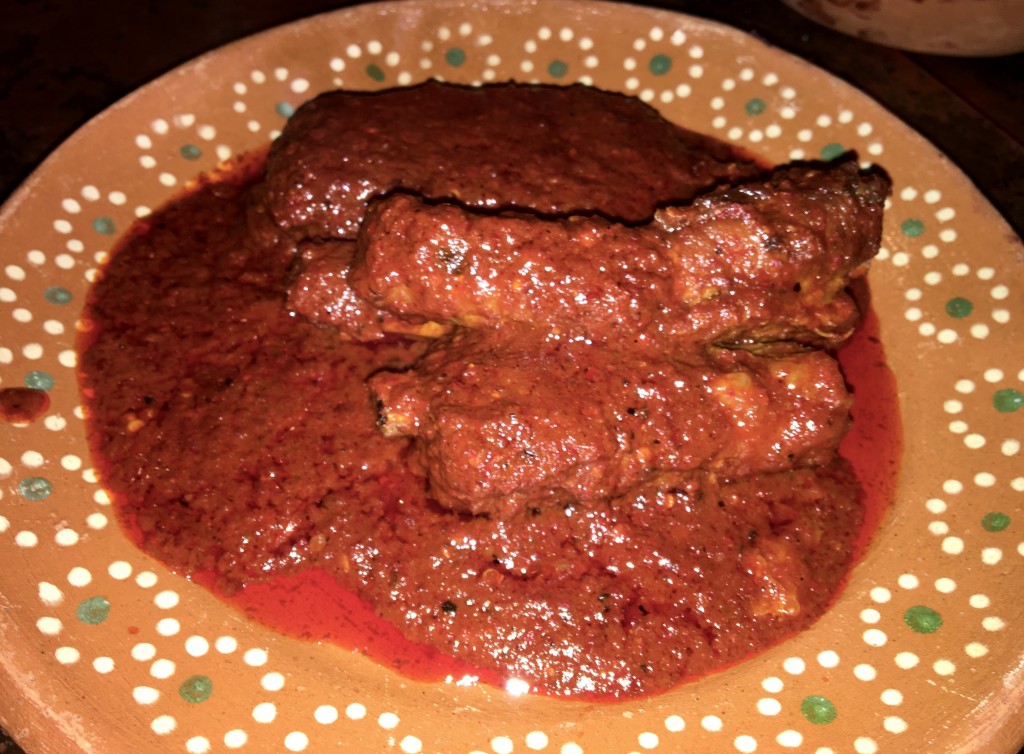
And then there are the vegetable enchiladas. No big deal: you’ve had enchiladas before. But these are stuffed with vegetables and… hibiscus. Yes, hibiscus: the reddish flowers – also known as sorrel, jamaica, or bissap – used to make a wide variety of teas and punch-like beverages that are popular throughout south Asia, Latin America, Africa (including Guinea), and the Caribbean (including Trinidad & Tobago).
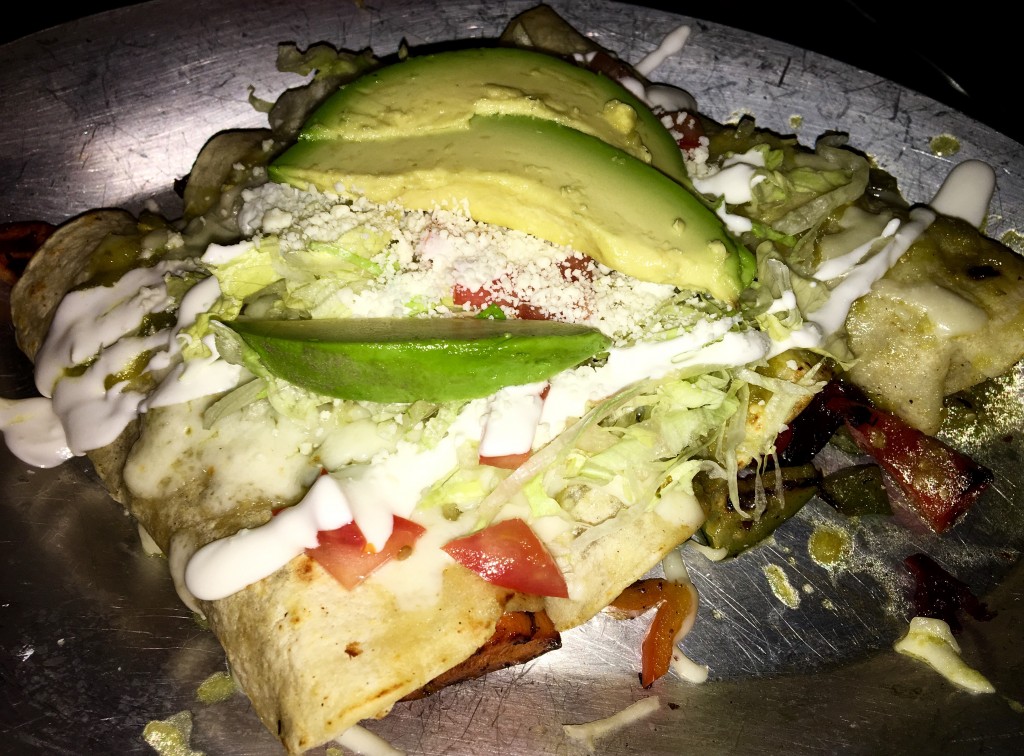
The hibiscus is a nice touch in an enchilada – a little bit citrusy, but not overpowering, and way more interesting than most California-burrito fillings. Sadly, you won’t find hibiscus burritos at Manhattan Chipotle locations just yet – but the South Bronx isn’t that far, right?

La Morada
308 Willis Avenue, Bronx
Subway: 3rd Ave – 138th Street (6 train)
|
|
|
My first thought on a recent Saturday morning went something like this: oh crap, I’m accidentally an a**hole.
The night before, a wonderful gentleman from Swaziland cooked an amazing meal for me. I repaid the poor lad with an epic, two-day hangover.
Here’s the scene: my friend Mfundi – a sharp twentysomething pharmaceutical consultant who has lived in New Jersey since graduating from Wesleyan two years ago – invited me to his East Orange apartment for a home-cooked Swazi meal on a Friday evening. The first time I met him, he told me that there are “plenty” of Swazis in the tri-state area. So I figured that there’d be a small crowd for dinner, and I brought two full bottles of hard liquor and a few mixers. It was the least I could do, right?
But then it was just the two of us. I’m not great at math, but I think that works out to one man per bottle. Until I started seeing double, which meant that I saw two men and four bottles, and that’s, like, 42 bottles per man.
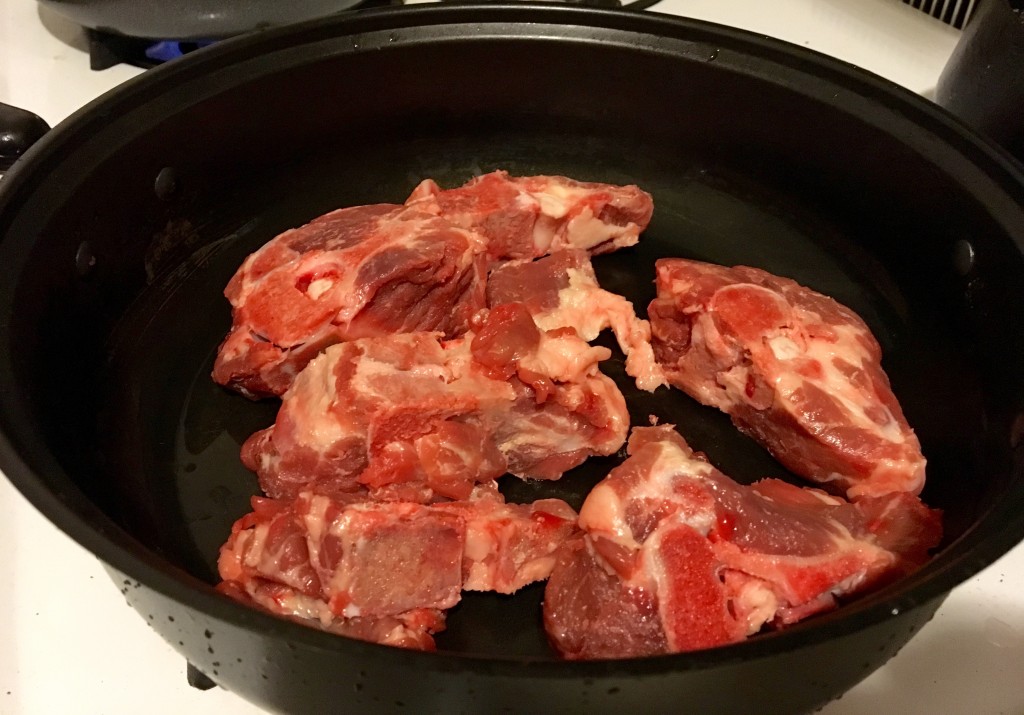
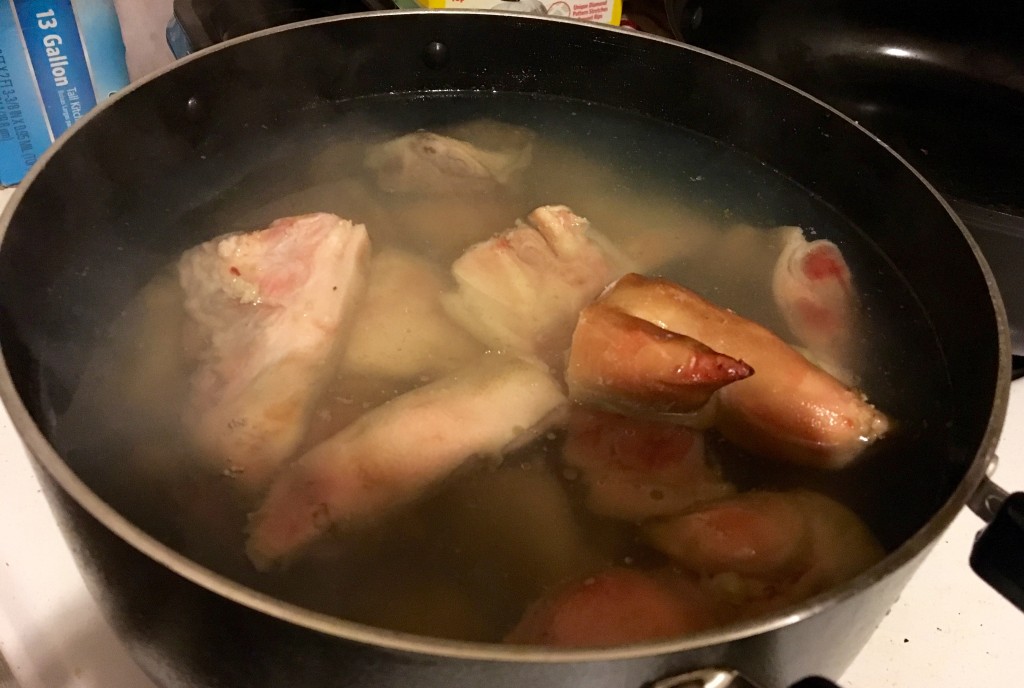 before jumbo cocktail #1: beef neck and pig’s feet
At around 8:30 in the evening, Mfundi started preparing two dishes: pigs feet with cabbage and a Swazi beef stew with beans and vegetables. He said that the meal would take about two hours, so I channeled my inner bartender and made two monstrous vodka cocktails, served in gigantic tumblers.
As we waited for the pigs’ feet and beef neck to boil, I made a second pair of jumbo cocktails. We finished those, started to wobble, and then started working with the other ingredients.
 after ginormous cocktail #2: I can’t quite tell whether the can of beans is upside down, or if we are
Mfundi chopped the cabbage, and tossed it in with the pigs feet. Meanwhile, the beef neck had thoroughly absorbed the water in its pan, and Mfundi started to add other ingredients: garlic, onions, tomatoes, spinach, diced habanero peppers, lemon pepper seasoning salt, a dribble of milk, a splash of olive oil, and some kidney beans that we pounded with a wooden spoon until they were thoroughly cremated.
To be clear: I did exactly none of the work, other than pounding some kidney beans with a wooden spoon. That, and pounding our heads with cocktails.
 during extra-large cocktail #3: these beans were my totally non-photogenic contribution for the night
I was trying to be useful, so I prepared cocktail #4 while Mfundi prepared two side dishes: greens stewed in peanut sauce, and some boiled sweet potatoes. (Incidentally, the sweet potatoes were not Mfundi’s first choice of starch: he originally planned to make mealie – white cornmeal porridge, similar to Malawian nsima – but couldn’t find the right type of cornmeal at the East Orange Shop-Rite.)
A full bottle of peach vodka and a half-bottle of mango rum later, dinner was served! At 1:00 in the morning.
Neither of us were remotely upset with the delay. After all, we were invincible by then.
 After mega-cocktail #4: we even had x-ray vision by the time he finished cooking. Um, this is totally what x-ray vision looks like, right?
The meal itself was slow-cooked and memorably delicious, even if your vision is blurry and you’re wobbling in your chair.
I was pretty excited about the pig’s feet as soon as we sat down to eat. “Ooh, pig’s feet. There are four on my plate. No, wait – now there are eight of them. No. There are four. Wait – eight!” Hopefully, I didn’t say any of that out loud, but I can’t really remember. I am, however, quite sure that I really enjoyed them – soft, fatty pork is perfect after a bottle and a half of hard liquor.
(Incidentally, Mfundi said that most Swazis don’t actually eat pig’s feet, but he happens to like them. “Swazis will read your post and say, ‘what the hell is this?’” he said, laughing, sometime after cocktail #2.)
The second entrée – the slow-cooked beef neck with beans, vegetables, spices, and a dash of cream and olive oil – bordered on divinity: a rich slurry of vegetables and crazy-soft beef, with a hint of citrus and pepper and garlic. I’d tell you the name of the dish, but the brain cell that registered that information was extinguished in a tragic rum accident.
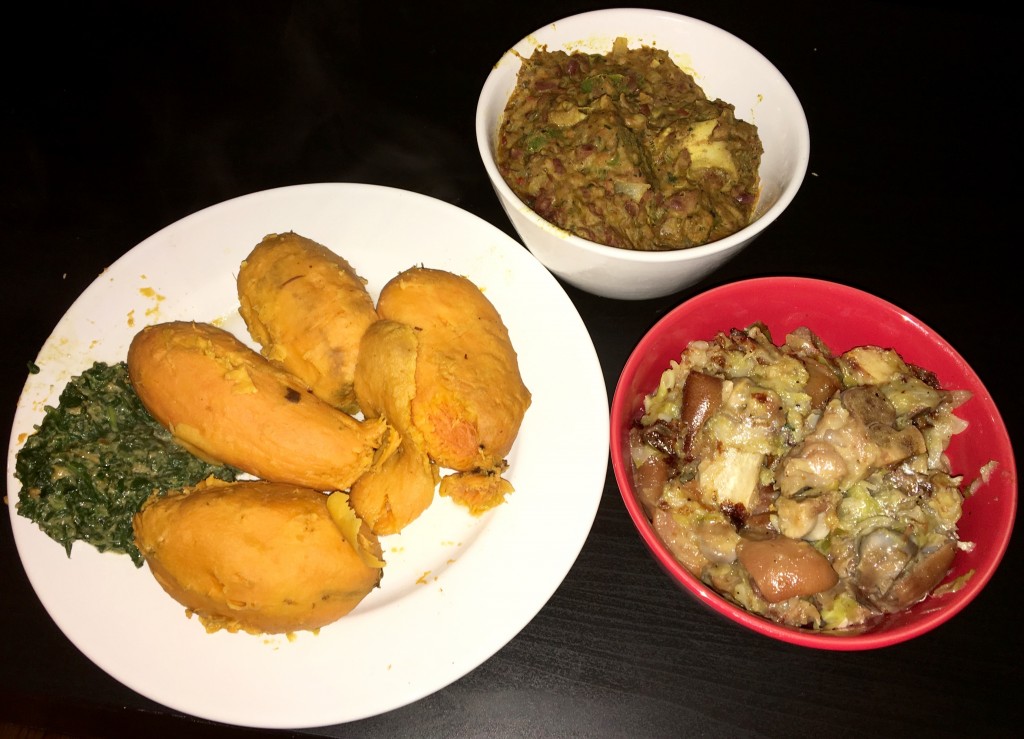 at least I remember very much enjoying this
By the time we were finished eating, it was 2:00 in the morning. Mfundi was barely upright. That, or he was perfectly upright, and I just didn’t realize that I was on the floor. I poured us both fifth cocktail, anyway. And then a sixth. By the time I finally arranged for an Uber ride home, it was nearly 4:00 in the morning.
Mfundi, being a warm-hearted gentleman, called me to make sure that my Uber driver had arrived. The following (Saturday) afternoon, he texted me, asking if I knew why he had called me at 4:00 that morning – he had only a hazy memory of the phone call. On Sunday, he sent me a message saying that he was still hung over from Friday night.
Clearly, Mfundi deserved something more pleasant than a two-day hangover after making such a great meal. I felt terrible about it.
But I can’t help but wonder: if he made such a great meal while I was wrecking his brain cells and liver, what could he do if I hadn’t bartended him into oblivion? If consulting doesn’t work out for him, maybe he has a future as New York’s first Swazi restaurateur. Especially if he doesn’t hire me as his bartender.
|
|
|
It’s one of the great mysteries of New York City: why are there something like 50,000 Nicaraguans in the Tri-State area, but no Nicaraguan restaurants anywhere in the five boroughs? I don’t get it.
Fortunately, I hit the Nicaraguan jackpot when I emailed Lidia Hunter, creator of the Nicas en NY y NJ Unidos Facebook page and the now-dormant Nicas en New York blog. She graciously spent pretty much an entire weekend(!!) with me, introducing me to some of New York’s Nicaraguan awesomeness.
My Nicaraguan weekend sprawled across three days. On Saturday night, Lidia invited me to a fundraiser in Crown Heights hosted by Las Primas, a Nicaraguan softball team. On Sunday, Lidia took me Discoteca La Boom in Woodside, site of a massive Nicaraguan party hosted by ExpoNica NYC. On Monday, I even had Nicaraguan coffee at Nica-owned Café Integral in Soho, accompanied by a charismatic Nicaraguan student I had met at a (non-Nicaraguan) event two days earlier.
So yeah: a whole weekend of Nicaraguan-ness! Honestly, the sheer quantity of amazing people and wonderful dishes made my head spin, in the best possible way.
That, or the Toña and Flor de Caña made my head spin. Or both.
I can’t possibly fit everything I learned about Nicaragua and Nicaraguan cuisine into a single blog post, but here are a few highlights of the weekend:
Vigorón
At the Las Primas event on Saturday night, the first plate of food I tried was delicious, and it had an absolutely glorious name: vigorón. My Spanish is rusty, but I think the rough translation is “big and vigorous,” which is pretty apt when you top boiled yuca with fried pork, a fresh cabbage salad, and a homemade Nicaraguan hot pepper sauce:
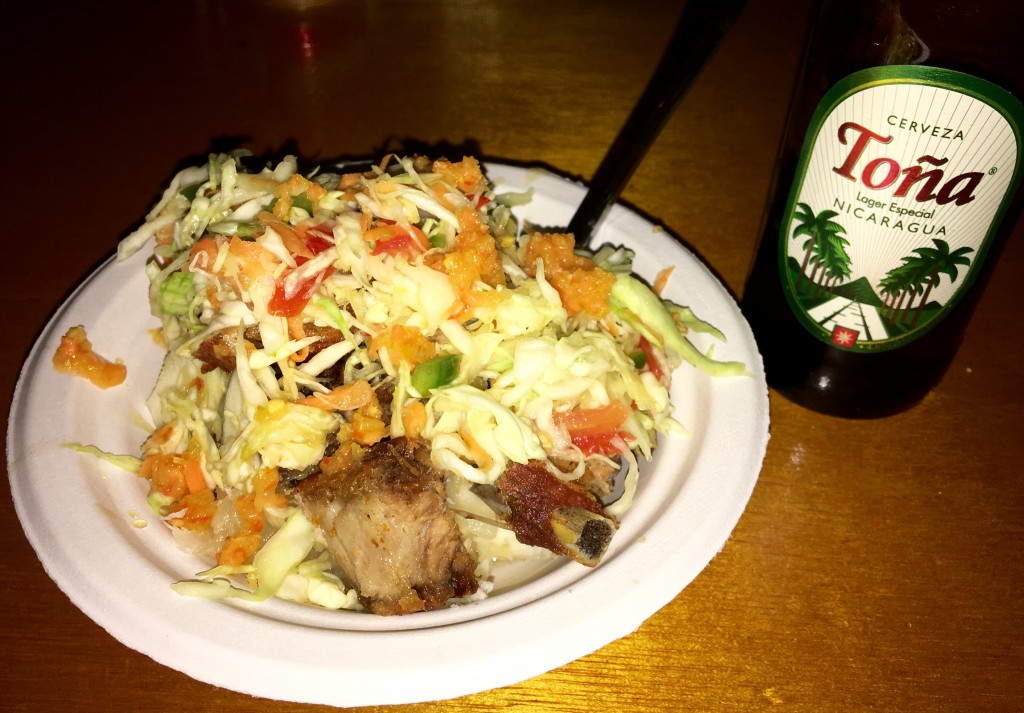 and a cold Toña gives you even more vigor
Fritos
Several Toñas later, the lovely ladies of Las Primas brought me some fritos. No, not those Fritos. These are much better than the packaged American type: the Nica variety features long, flat slices of crispy fried green plantains, topped with stewed pork, cabbage salad, and – if you’re into that sort of thing – more hot sauce. Nicaraguan fritos are pretty much everything you could possibly want from nachos, except with more pork and tastier “chips.” Epic.
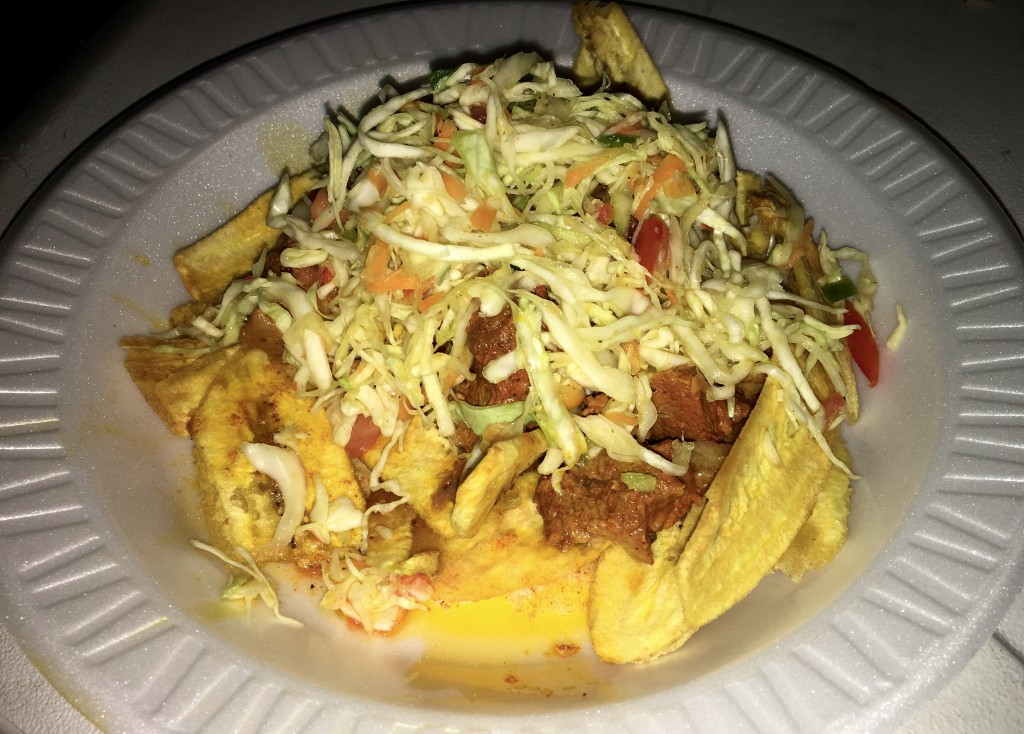
Palo de Mayo (Maypole)
So there’s this tradition that I’d somehow never heard of: pole dancing.
No, not that kind of pole. This is a maypole, better known as palo de mayo in Nicaragua: basically, a tree covered in ribbons that becomes the center of dance floors in the springtime.
I’m sure that there’s a long, fascinating story behind it, but rumor has it that the Nicaraguan palo de mayo somehow evolved from the European tradition of ribbon dances. On Saturday, my Nicaraguan companions explained that the tradition took on a local flavor as it spread first to English colonies in the Caribbean, then to parts of Central America. Roxy, one of my new friends from the Caribbean coast, theorized that the ribbon dance became intertwined with existing Caribbean and Central American fertility rituals, leading to a decidedly sensual, non-British style of dance.
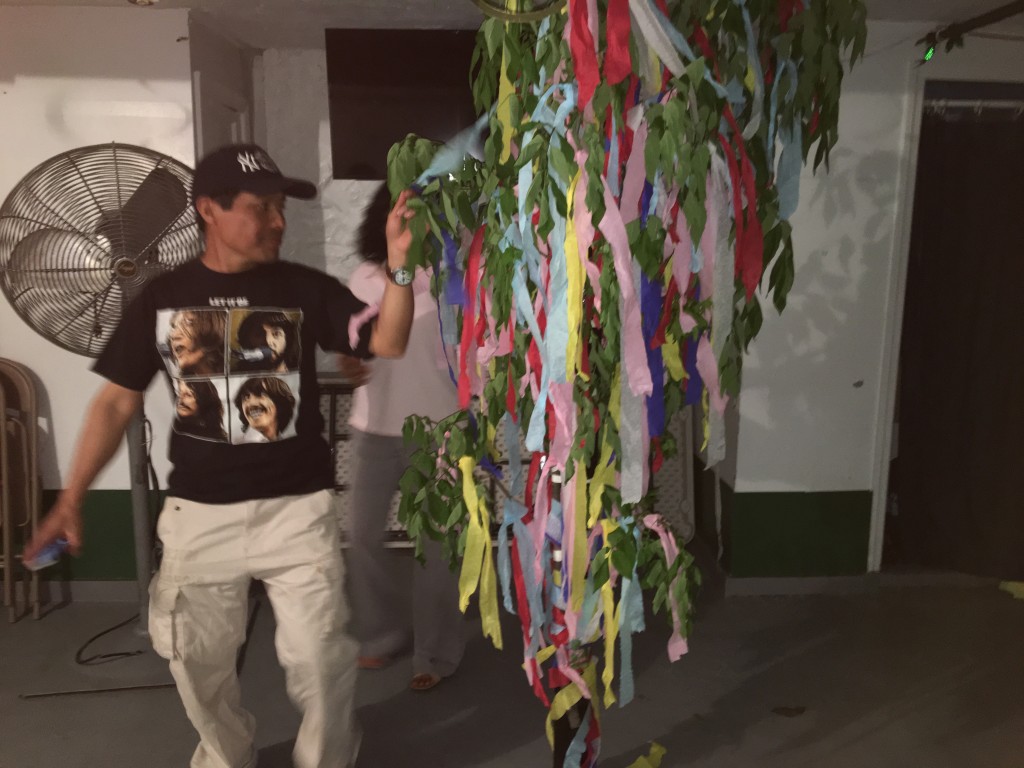 Guillermo and a maypole; sensual, non-British style of dance not pictured
Patties
There is incredible regional variety in Nicaraguan cuisine, and when one of Las Primas passed me a plate of Nicaraguan beef patties, my new friend Hopee – from the northern Nicaraguan state of Matagalpa – looked confused and asked, “What’s that?”
 What, this? It’s really good rum, served with a side of patties…
Apparently, Nicaraguan patties aren’t terribly common outside of the Caribbean region. The version I tried – which most likely evolved from Jamaican patties – was stuffed with some beautifully seasoned ground beef. The result is fantastic, and reminds me of the wonderful baked empanadas I ate in Chile, except that the meat is more finely minced, and has more spice to it. Great stuff.
Enchiladas
On Sunday at Discoteca La Boom, the team at ExpoNica NYC kicked off my evening of Nica food with enchiladas. No, not Mexican enchiladas. The Nicaraguan type resembles a lightly fried empanada, stuffed with beautifully peppery ground beef. On this particular day, the enchiladas were served with a fried ripe plantain and some addictive, salty, fried Nicaraguan cheese, which reminded me of a fried version of the haloumi at my favorite Greek Cypriot restaurant.
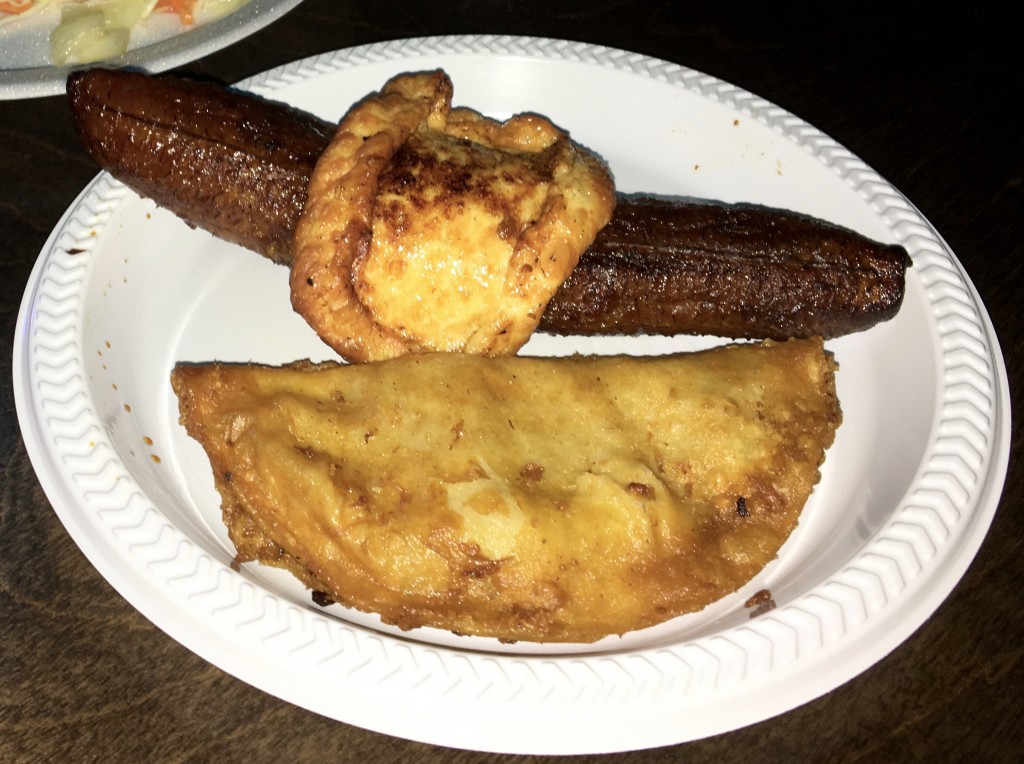 fried Nicaraguan awesomeness
Sunday’s band: La Nueva Compañia
I love these guys – they’re a band from Managua, currently on tour in the United States. My friend Hopee explained that most of the songs they played on Sunday were high-energy homages to some aspect of Nicaraguan culture or history. Such fun music, even if I didn’t always understand 100% of the lyrics.
Plus, those straw hats are pretty epic.
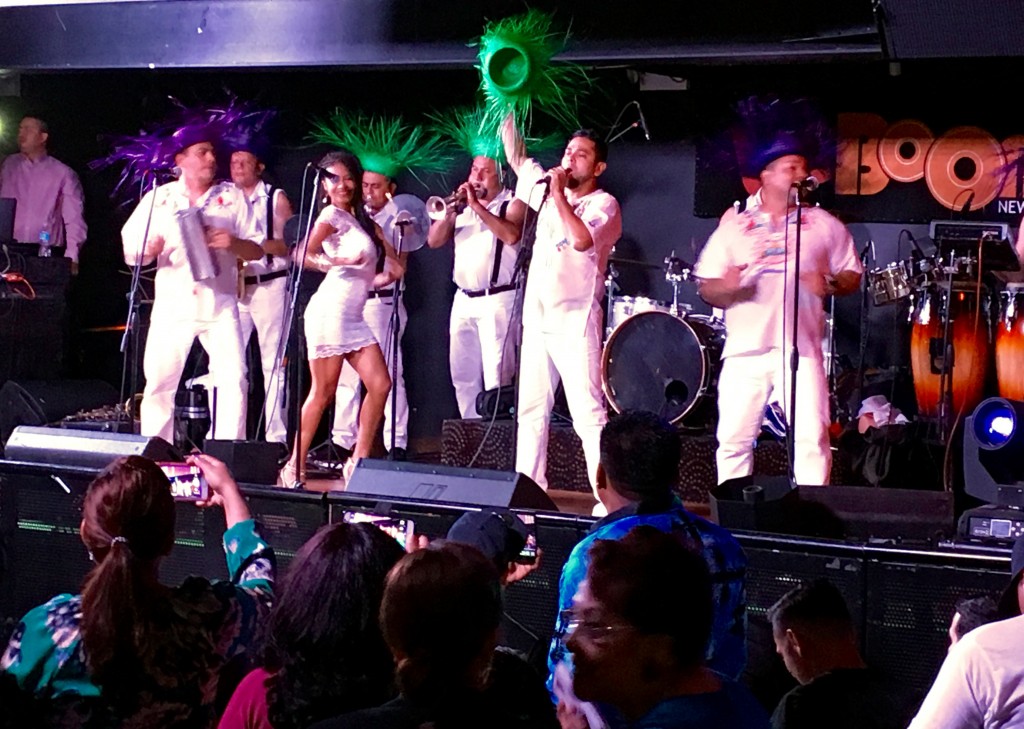
Nacatamales
You’re surely familiar with Mexican tamales, but these beasts make the Mexican sort look downright scrawny. Nacatamales are meal-sized, and closer in spirit to the epic Belizean tamales you can get in Linden Park, except that the ingredients are a little bit different: the corn masa is silkier, and it’s studded with pork, onions, garlic, tomato, peppers, green olives, and raisins, among other treats – and wrapped and steamed in a banana leaf.
Also pictured: a nice, cold cup of Nicaraguan cacao — a rice-based drink that vaguely resembles horchata, but with a much richer flavor from the cinnamon and fresh Nicaraguan cocoa beans.
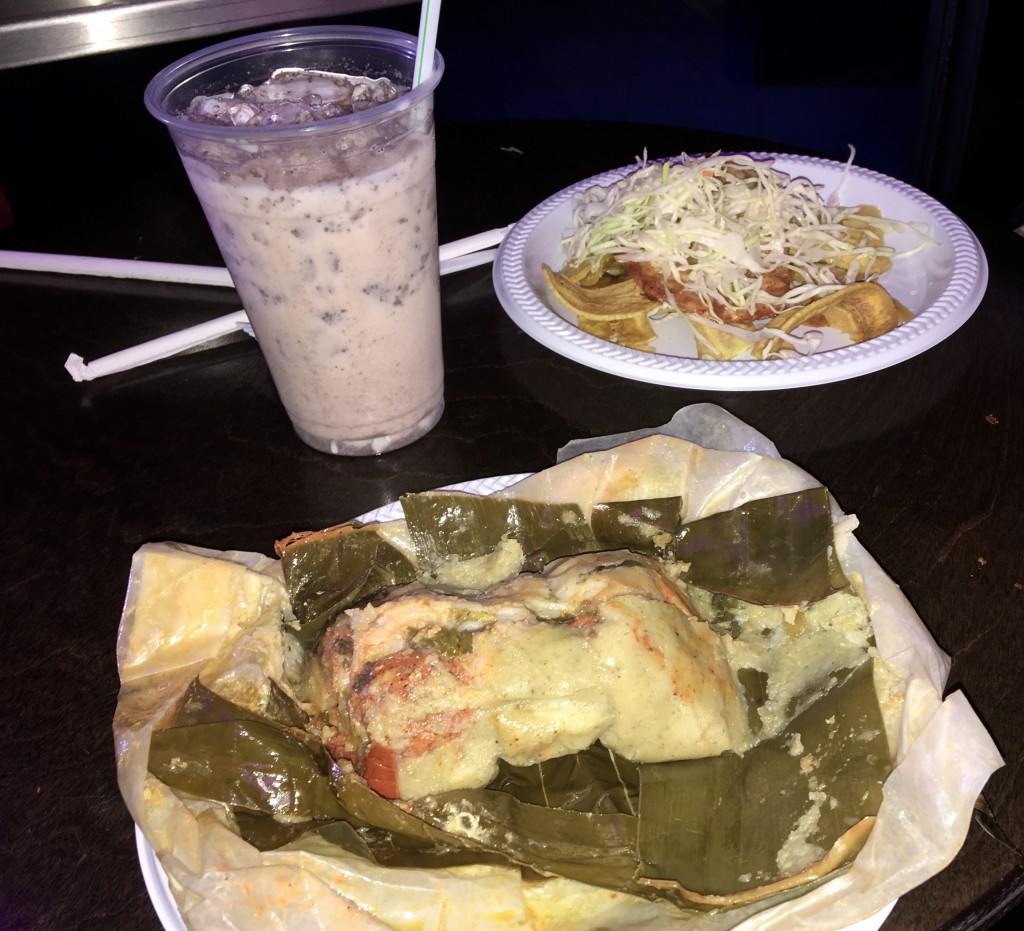
Stuff I didn’t eat: pupusas and rondon and lobster soup and…
Of course, the Nicaraguans I met eagerly described other amazing Nicaraguan dishes that we didn’t happen to have in front of us. A sampling:
- Rondon: a dish from the Caribbean coast, vaguely similar to Grenadian oildown – vegetables, meat, and/or fish, stewed forever in coconut milk and spices. (Whimper.)
- Nica pupusas: I’ve had countless Salvadoran pupusas, but my friend Eduardo – from the northern city of Estelí – explained that the northern Nicaraguan version is made by mixing tomatoes and peppers into the corn masa, giving the pupusas a reddish hue and more flavor. Sign me up!
- Lobster soup: apparently, the Corn Islands – off the Caribbean coast – have a time of year called “lobster soup.” Basically, everybody makes – well, lobster soup. You can wander around from bar to bar – or house to house – drinking Toña or rum and eating lobster soup, often offered by complete strangers. Sounds amazing.
I could go on and on. Every time I ate something wonderful, somebody told me about something else I needed to try, often available in only one corner of the country. My friend Hopee, from Matagalpa in the north, explained that she sometimes won’t even recognize food from other regions of Nicaragua; in terms of cuisine, Managua or the Caribbean coast might as well be a whole other country.
All of this culinary diversity from a nation that’s smaller than New York state. Pretty awesome.
And the very best thing that I experienced over the weekend was… drum roll please…
Nicas
Yeah, I ate great food all weekend, since – well, you know, eating is my only real skill. But sometimes the food takes a distant, distant backseat to the fantastic characters I meet.
I fell in love again and again over the weekend with all sorts of friendly people: the charismatic DJ who spent half an hour talking about Nicaraguan music and dance traditions, the fleet of chefs who patiently walked me through their cuisine, and the complete stranger who offered me a ride home – from Crown Heights to Astoria, far out of his way! – when he saw me leave the party and head toward the subway on Saturday night. Everybody I met had a nearly magical way of making me feel like an honored guest and a long-lost cousin, all at the same time.
So of course I loved the big, hearty plates of Nicaraguan food. But at the risk of sounding totally cheesy, I was even more enthralled by the big-hearted people I met. You rock, New York Nicas.
Huge thanks to all of the incredible people I met during the weekend, including Hopee, Eduardo, Gema, Gladys, Shanell, Roxy, Jaykel, Evelyn, Guillermo, Marlene & Rolando from ExpoNica, ExpoNica chefs Martha Saballos and Maria Mercedes Caceres… and especially Lidia Hunter, who made all of this possible. Lidia, you’re a saint!!!
 Saint Lidia, with Gema from Las Primas
|
|
View My Favs!
Search This Blog
Food By Region
|


















































